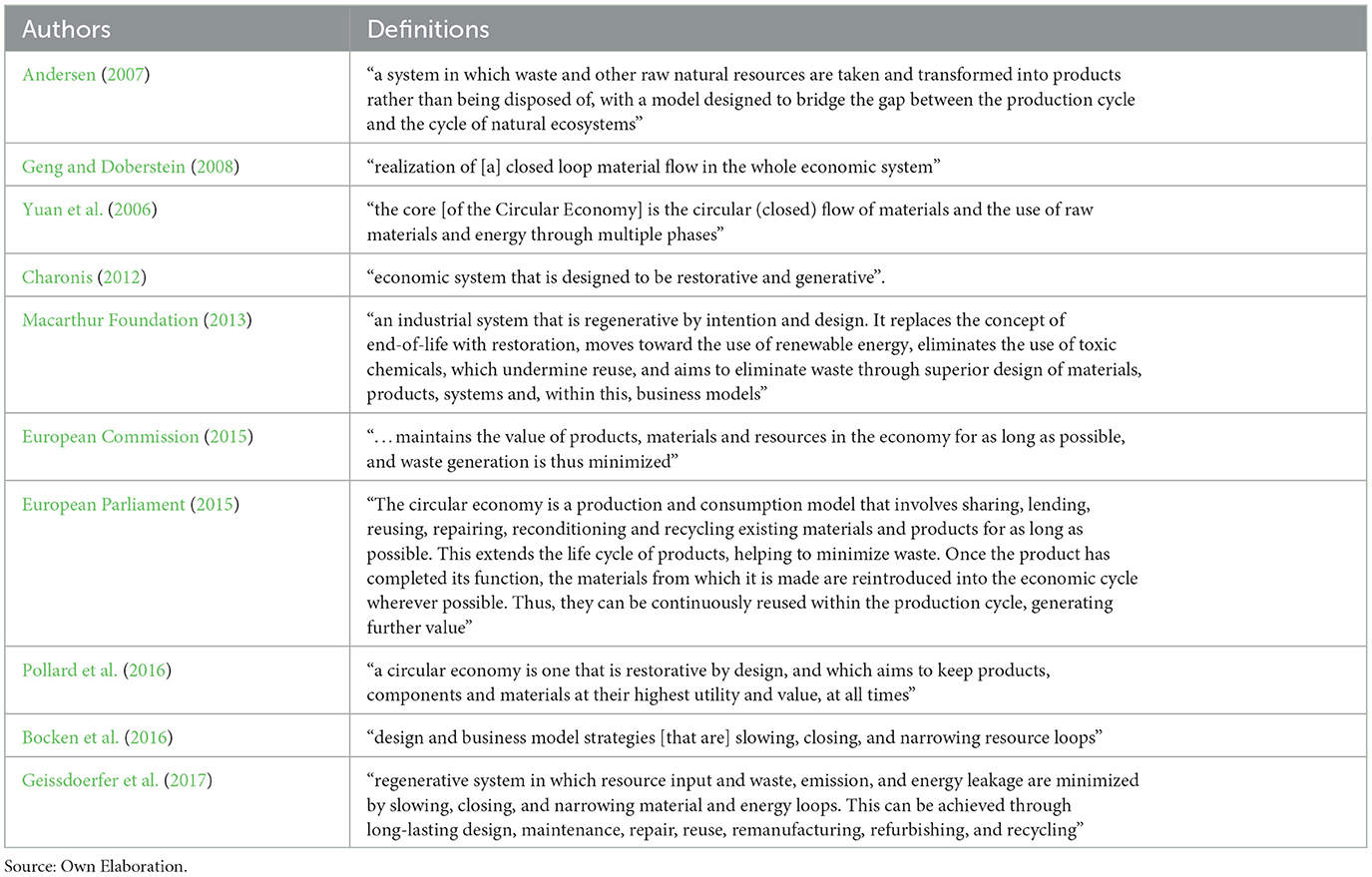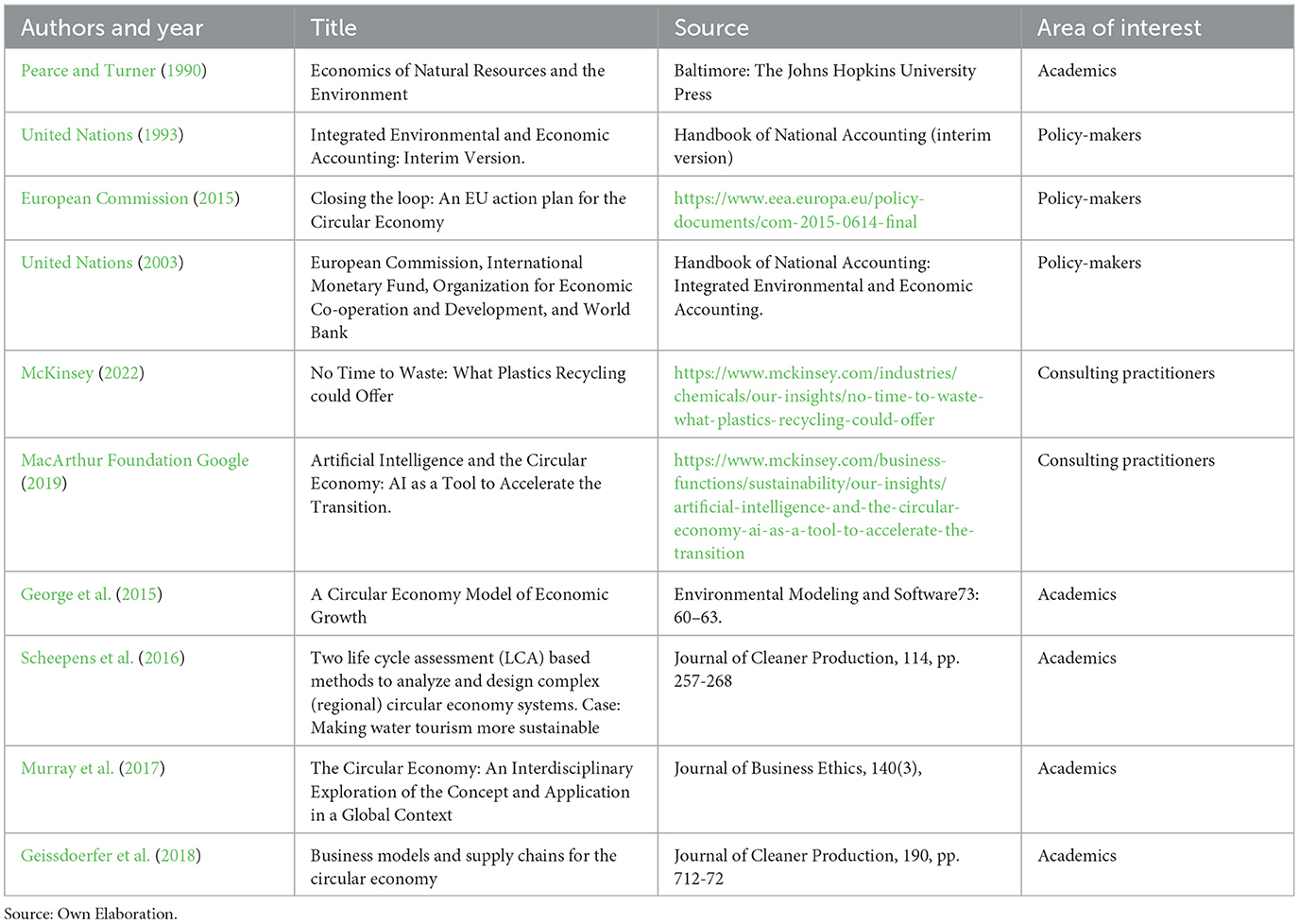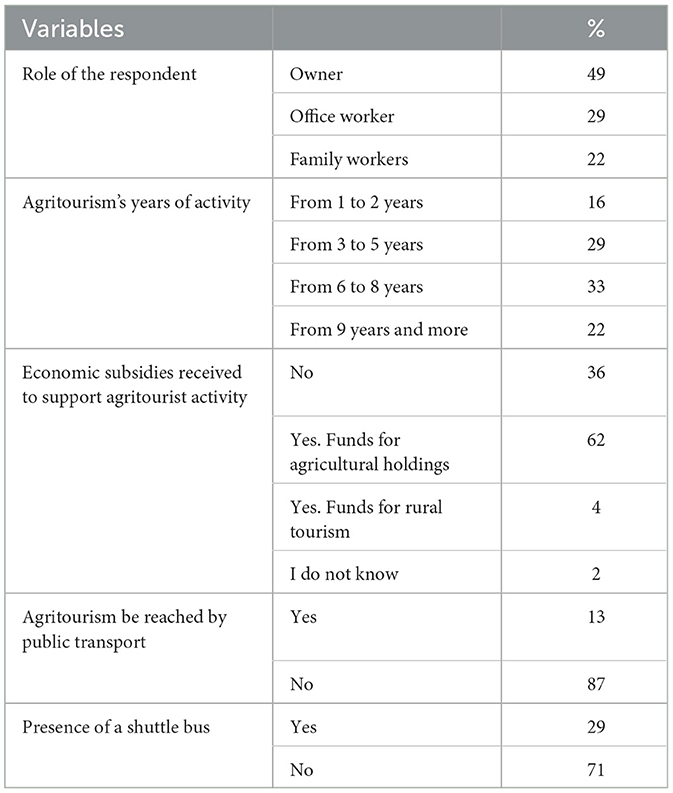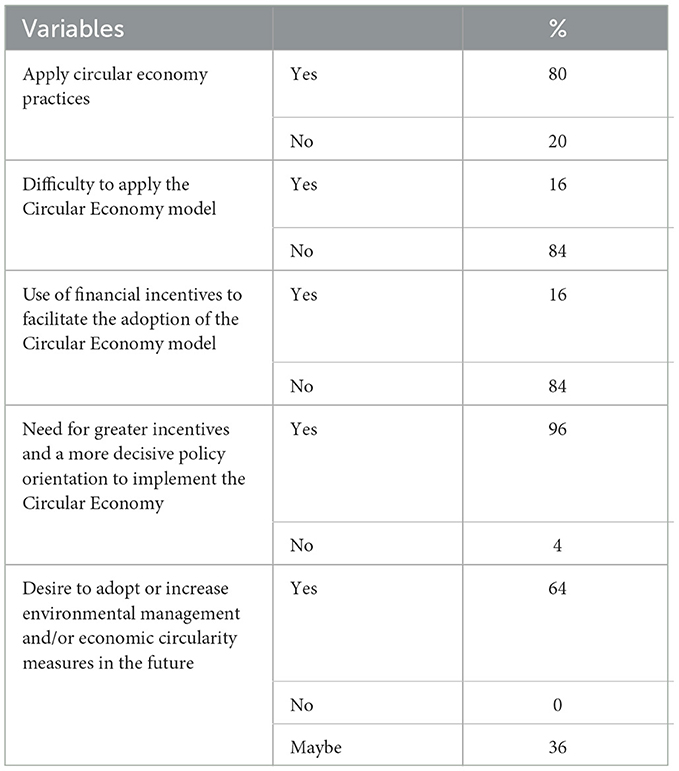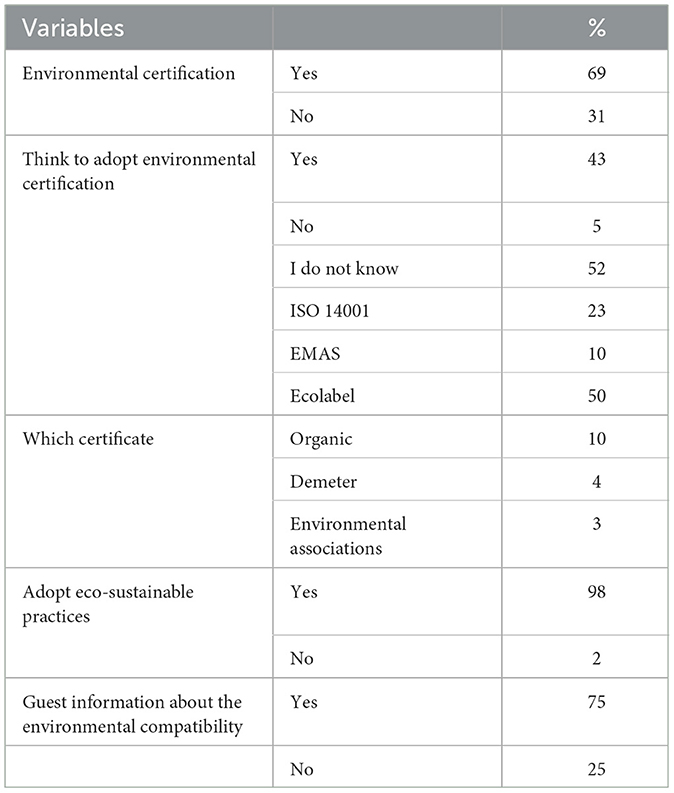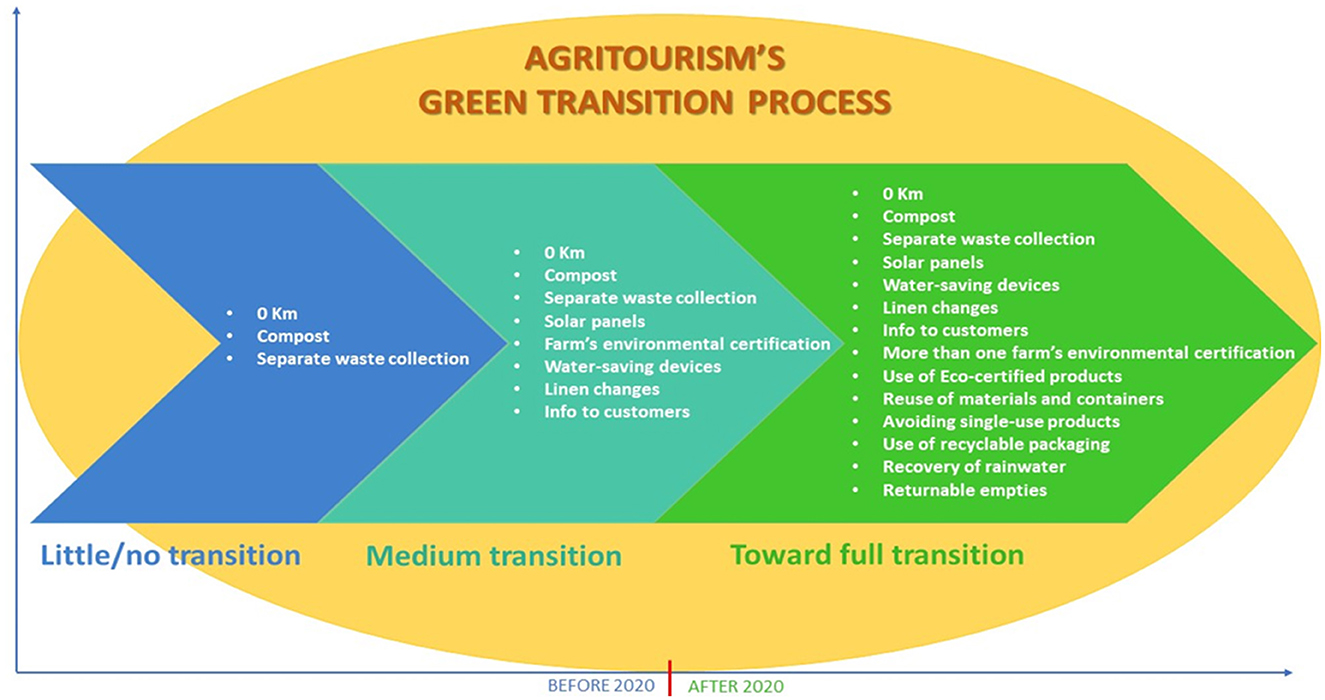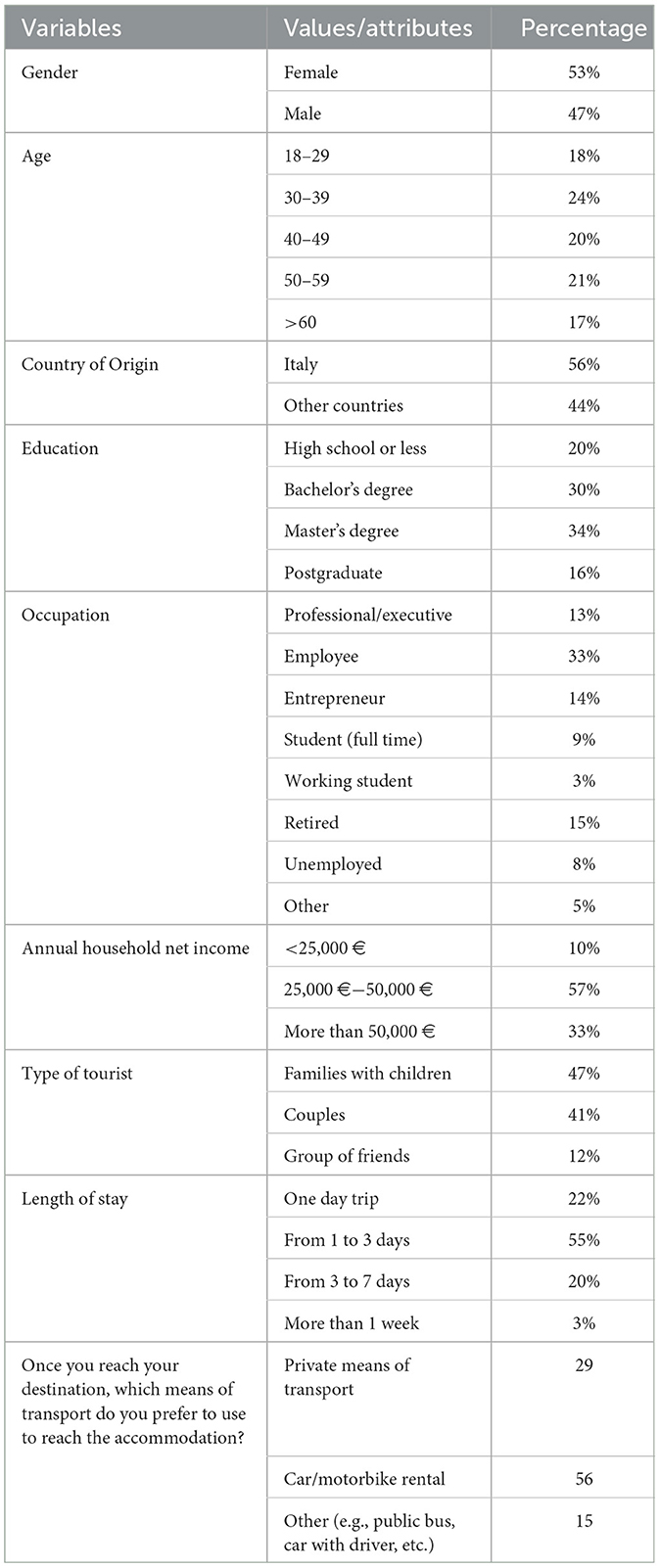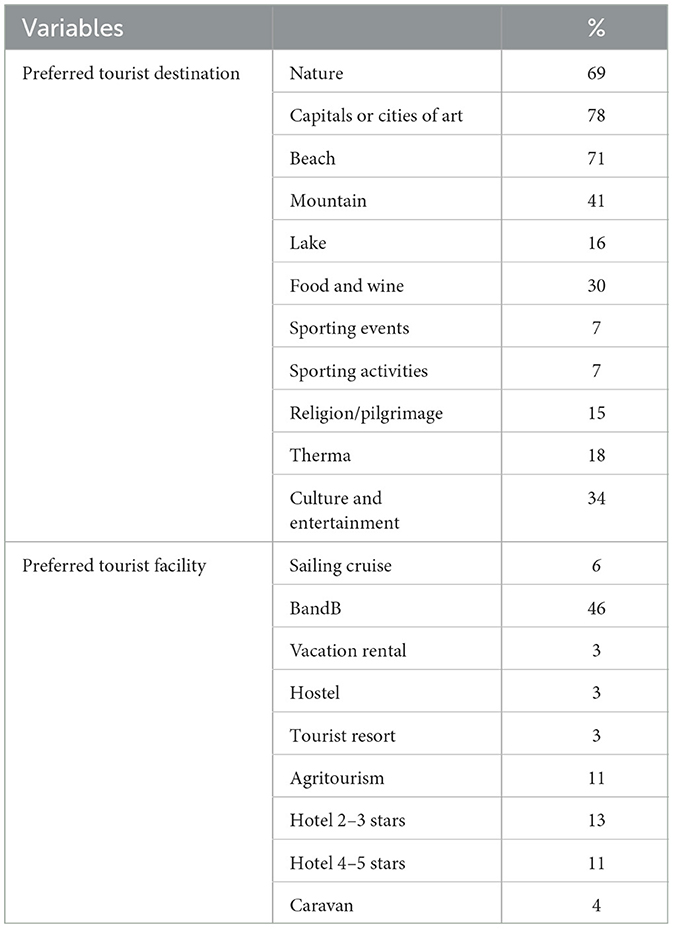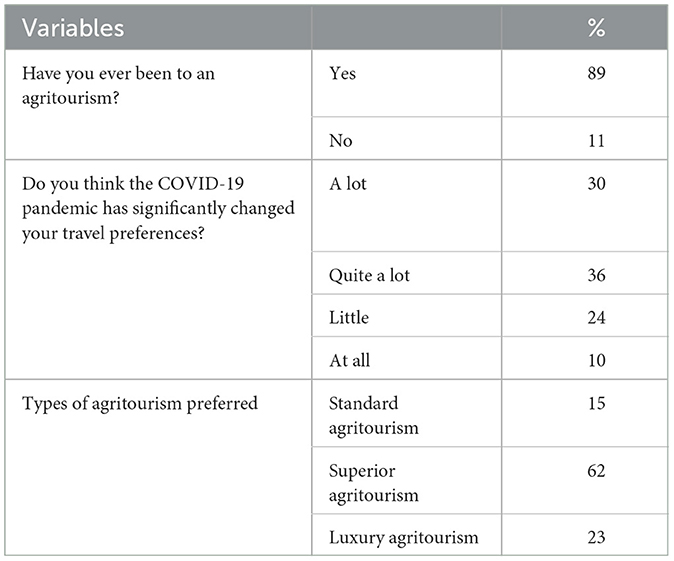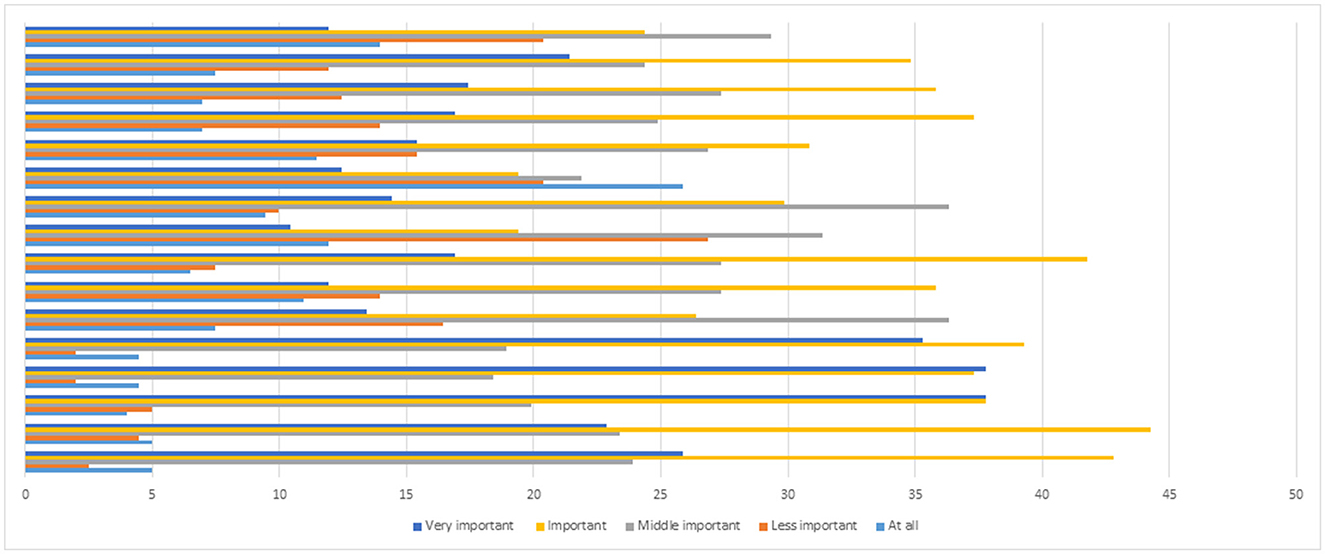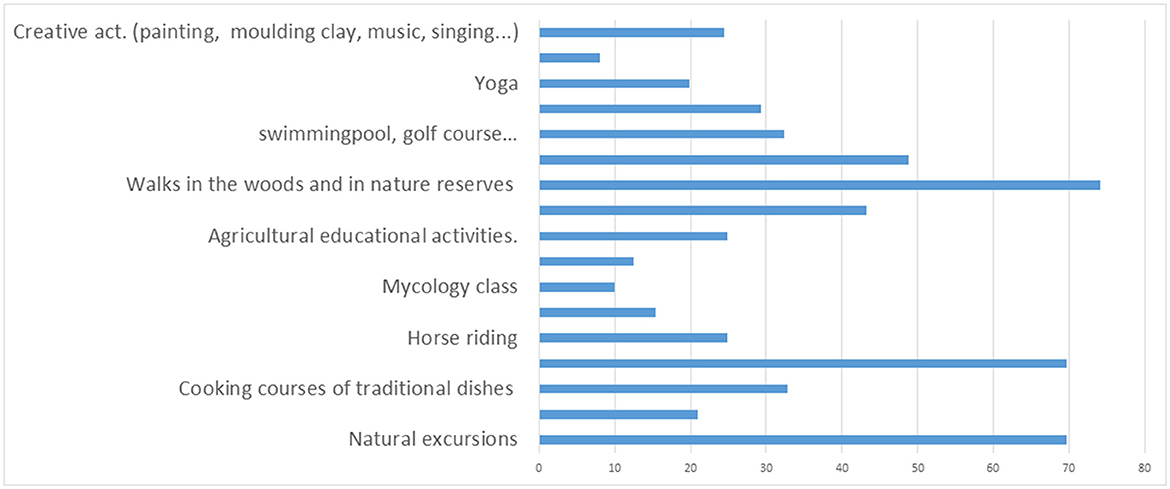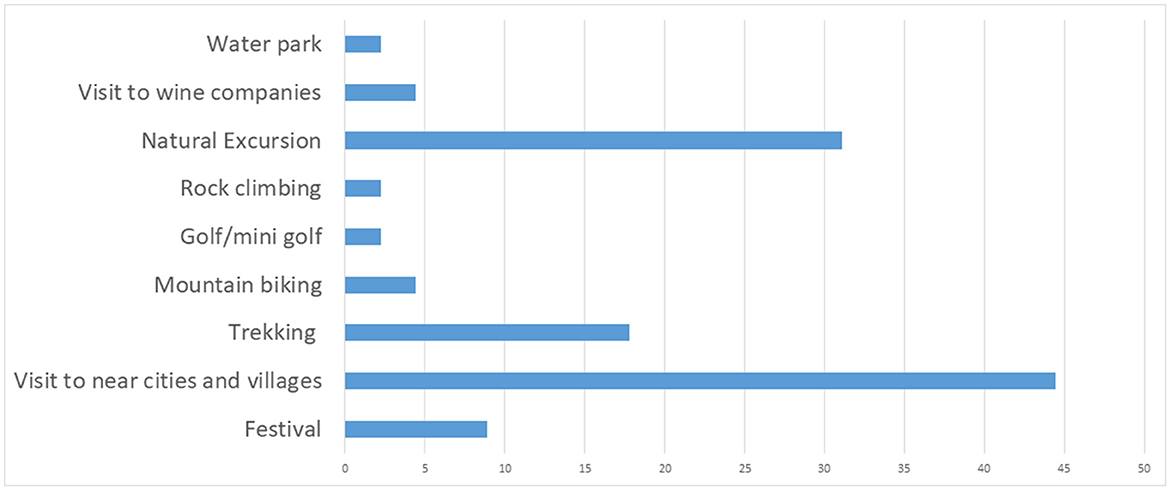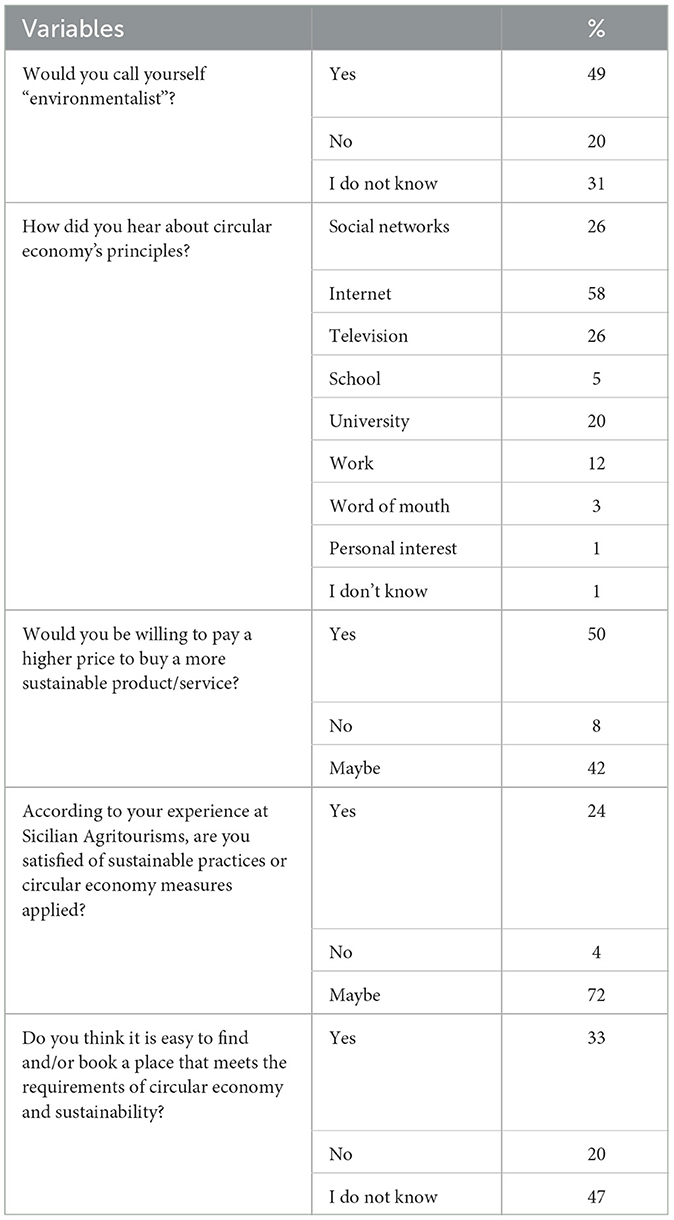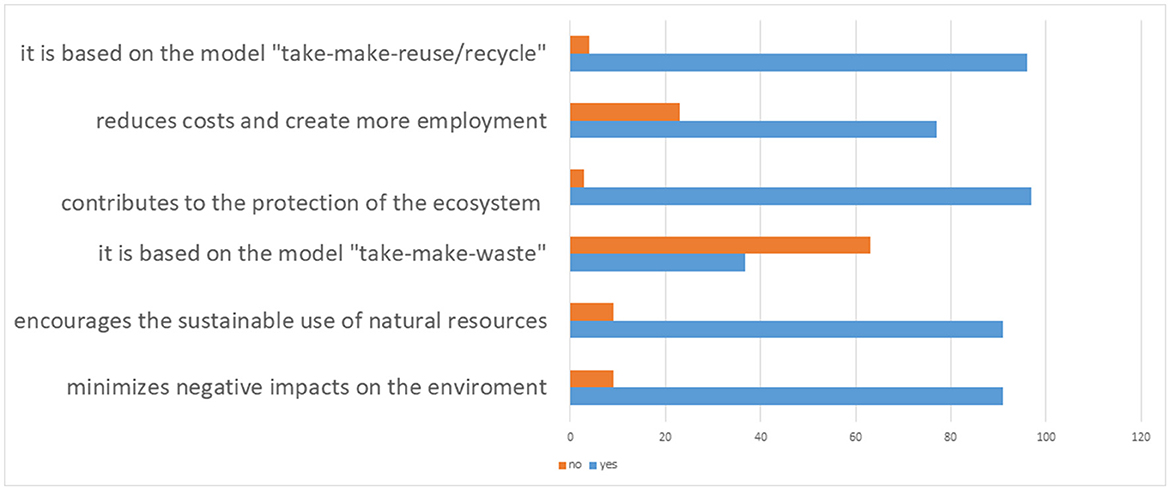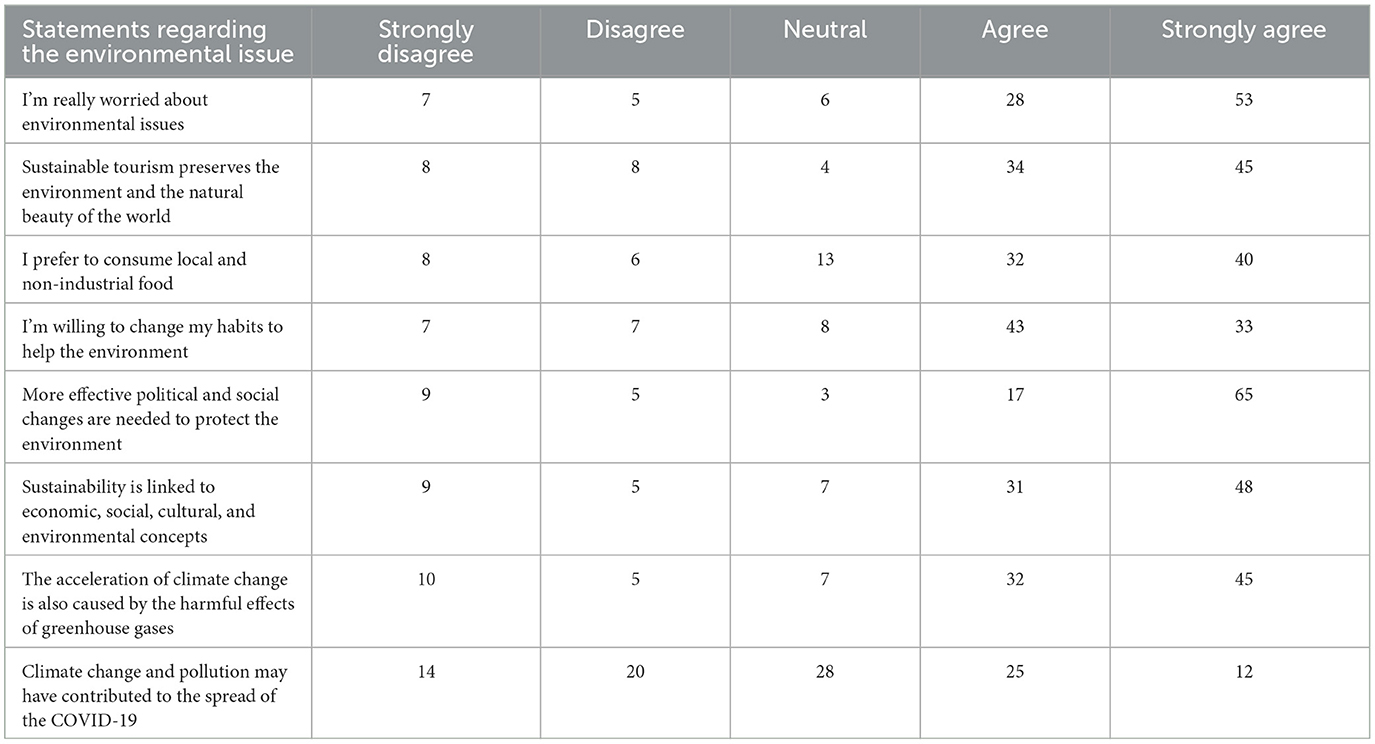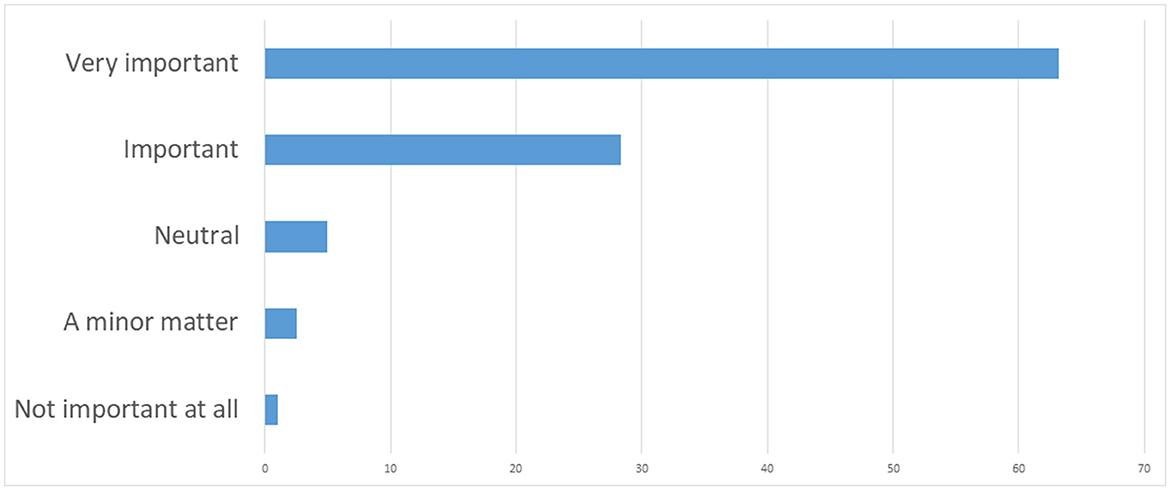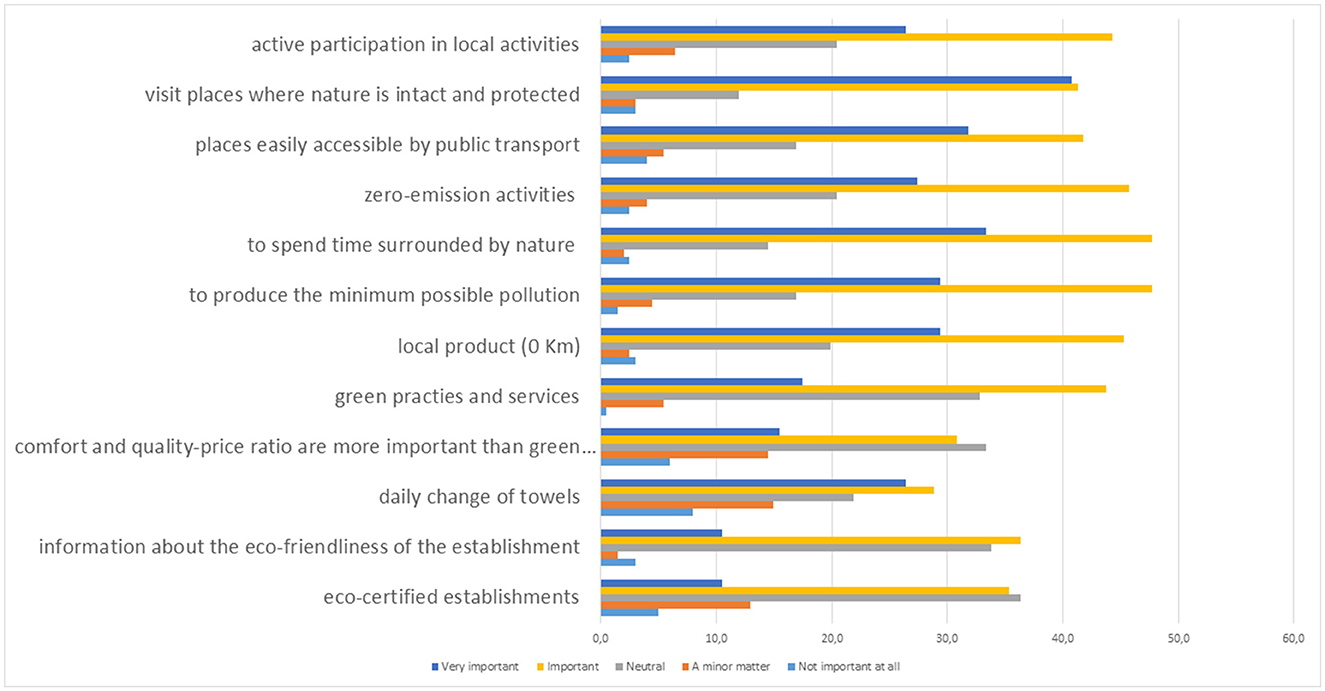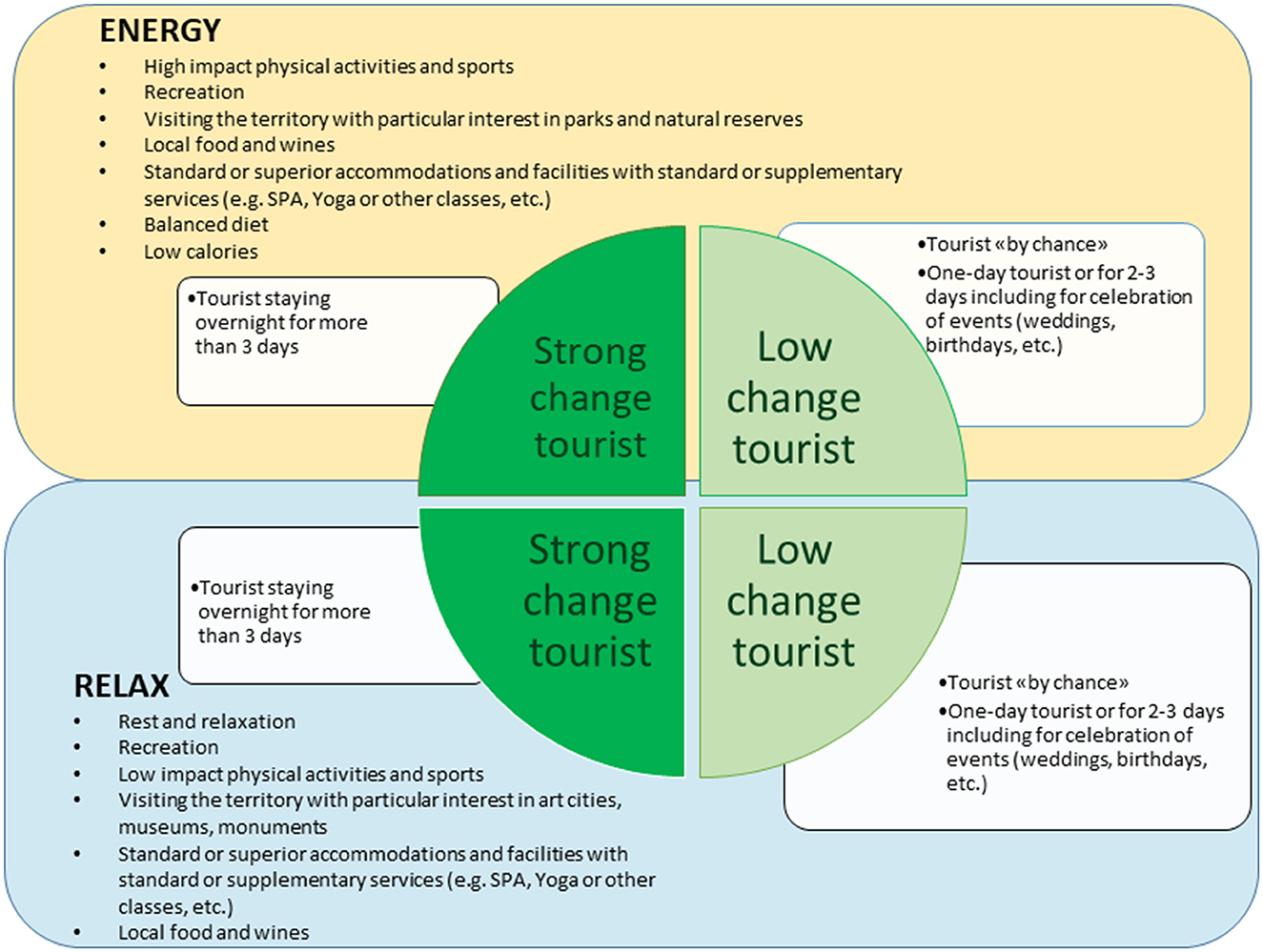- 1Department of Agriculture, Food and Forestry Sciences, Università degli Studi di Palermo, Palermo, Italy
- 2Department of Agriculture, Food and Environment, Università degli Studi di Catania, Catania, Italy
Introduction: In recent years, issues related to environmental and ecosystem protection have been given greater consideration than in the past. The goal of adopting sustainable development models is vigorously pursued in the European Union and is reflected concretely in the new Common Agricultural Policy 2023-2027. The circular economy can certainly be an emerging economic response that can effectively replace growth models centered on a linear view. Agriculture and tourism are two crucial sectors where the “green transition” should be encouraged to help achieve sustainability goals through economic circularity. Agritourism's activity may be relevant in contributing to a behavioral change based on ethical choices. The study aim is to find out if agritourism can be the forerunner for the green transition. The objective is to know motivations and current level of awareness and adoption of concrete behaviors of the circular economy by agritourisms and their guests. The tourists' preferences for Sicilian agritourism offerings were also observed.
Methods: Two types of surveys were conducted: a Census of the Sicilian Agritourisms active at an online travel agency and a sampling survey of the agritourism's visitors.
Results and discussion: The results showed that agritourism by its very nature carries the green transition, partly due to the enormous financial support of the new CAP. Second, it is a provider of quality food and ecosystem services, and a promoter of healthy behaviors and consumption of seasonal and local short-chain products by visitors, so it can be a vehicle for the adoption of the Mediterranean Diet as a sustainable lifestyle and food system. Tourists' propensity to seek out environmentally friendly products and green services can help to improve ethical, responsible, and sustainable tourism. A sustainable behavioral model for farmers and tourists was provided.
1. Introduction
In the new millennium, sustainable and efficient use of resources is the challenge that stimulates a better change in the way to produce, consume, and, ultimately, live. This challenge turns out to be increasingly important, especially for businesses operating in the agricultural sector (Whitfield et al., 2018). The answer to this challenge may be the attempt to meet the current demand for food, growing due to the increase in world population, using agricultural practices and techniques that allow for improving farm productivity and provision of environmental services without reducing resources, and at the same time regulating wastes and negative environmental externalities. The search for obtaining higher productivity “at any cost”, typical of the post-industrial economy, through the increasing use of non-renewable resources, caused excessive use of inputs and rise of environmental costs. The intensification that has occurred in “conventional” agriculture often was accompanied by inefficient use of resources that damaged progressively the ecosystem. Although during the last 30 years, it was generally acclaimed that the production system based on value creation structures built on the linear model of extraction, production, consumption, and disposal are detrimental to the terrestrial ecosystems, only in the last 5 years, there has been a more concrete commitment by the European Union (EU) to the ambitious environmental and climate goals (Ghisellini and Ulgiati, 2020).
In addition, the COVID-19 pandemic in 2020 and the conflict between Russia and Ukraine in 2022 have further highlighted the fragility of our economic development model. Therefore, the EU has further accelerated its transition path (initiated in 2019 with the presentation of the European Green Deal) to a circular economy (CE) and sustainable development (SD), designing a resilience model based on energy independence, reduction of social and sanitary inequalities, and processes and behaviors more and more “digital” and “green” (Ingrassia et al., 2022a).
At the same time, the emphasis on issues related to protecting the environment and biodiversity has also increased considerably among people. The growing interest in “green” policies reflects a concerned society, more aware of the actual conditions of our planet. According to the literature, avoiding food waste and surplus become an issue also for consumers progressively moving toward diverse and healthier food patterns (Gómez and Martinez, 2023; Pedrotti et al., 2023).
In addition to the above, the COVID-19 pandemic has influenced individual behavior. The need to enjoy open spaces and stay in contact with nature has become of primary importance, particularly for urban citizens that felt a stronger need for vacations far from cities (Ingrassia et al., 2022a). Moreover, there was a decisive push to the very slowly initiated green transition. A rising desire to become more responsible for daily actions, also during traveling, was observed (Nocca et al., 2023). However, there is still a certain skepticism about recycled and reclaimed materials (Keränen et al., 2023).
In this framework, agriculture takes on a crucial role in green transition and sustainable efficiency. The circularity of the agri-food system is one of the prerequisites for achieving an optimal balance between economic and environmental sustainability. Circular economy (CE) in the agricultural sector regards the reduction of wastes generated in the production system, the recovery of food surpluses and waste, the use of by-products and food waste, the recycling of nutrients, and the production of biomaterials, but also changes in the food dietary and consumption regime were adopted (Renting et al., 2009; Ingrassia et al., 2022b).
The European model of agriculture was formulated in response to growing pressures from outside and within the European Union to reduce price support for agricultural commodities and introduced the philosophy that sufficient numbers of farmers ought to be kept on the land to sustain the characteristic landscape appearances and social structures of rural areas that are valued positively by wider society. Within this approach, at least at the theoretical level, agriculture is seen as one of several economic sectors in the countryside which, in combination with other activities—such as tourism and services—should guarantee the sustenance of viable livelihoods and quality of life in rural areas (Kachniewska, 2015). The concept of Multifunctional Agriculture (MA) was first introduced at the Earth Summit in Rio in 1992. Broadly speaking, MA refers to the fact that agricultural activity beyond its role of producing food and fiber may also have several other functions such as the management of renewable natural resources, landscape, conservation of biodiversity, and contribution to the socio-economic viability of rural areas. However, the meaning attributed to multifunctionality in international debates is ambiguous, as various institutions have adopted the term with slightly different interpretations and in relation to different policy agendas. Another tradition in the use of the concept can be traced back to the Food and Agriculture Organization (FAO) which more specifically refers to the situation in developing countries focused on the varied nature of agricultural activities and its multiple contributions to livelihood strategies of households and rural development. FAO uses the notion of multiple “roles of agriculture” (Bresciani et al., 2004), which in addition to environmental externalities also covers contributions of agriculture to development challenges such as food security, poverty alleviation, social welfare, and cultural heritage. A third important, and again different, contribution to the debate on MA is associated with the reform of the Common Agricultural Policy (CAP) of the European Union, which from the 1990s onwards adopted multifunctionality as an important cornerstone of its European Model of Agriculture. Indeed, the first official recognition of MA in the EU comes with the Agenda 2000, a package of reforms approved in 1999 inside the CAP that covered the period 2000–2006. From that date on, issues such as environmental protection and biodiversity began to take on an increasingly strategic role and weight in the CAP, so much so that they increasingly condition EU aid and funding toward the sector.
The EU farmers are nowadays facing new and more ambitious challenges in the market, innovation, and environmental-economic sustainability. The multifunctional farm, generally, carries out also activities of tourist reception and offering/selling of its products to the guests (direct sales), plus other educational activities (educational farming, agri kindergarten, and social agriculture), and can be defined in one term as agritourism activities. Moreover, a multifunctional farm also has other tasks, including maintenance of public green spaces, preserving the rural/agricultural local landscape and environment, using alternative energies, and overall contributing to the rural development of the territory, also increasing its tourism potential.
Certainly, strategies for the conservation and enhancement of the rural landscape have long been of growing importance, within the policies of individual EU countries (Pappalardo et al., 2018). In the past, the landscape was considered exclusively the place of primary production, but today, it is a multifunctional container able to promote the modernization of agricultural structures and the enhancement of territorial resources (environmental, tourist, social, etc.) in full respect of the environment (preserving biodiversity), climate, and the health of the inhabitants of rural areas as well as consumers of food products grown in them (Pappalardo et al., 2018). Agriculture, beyond the traditional role of food production, also assumes a service function for the community through the protection of the environment and natural resources, seeking integration of people with nature and the local territory (Sisto et al., 2022). Ultimately, thanks to the MA, the EU not only aims to support farmers' incomes by introducing the possibility of carrying out complementary activities to agriculture but also aims to ensure the maintenance of rural areas integrated with the peri-urban and urban territories through the enhancement of specific endogenous resources. Therefore, multifunctionality is not only in favor of the users and the environment but also a diversification of income sources for farmers which allows them to reduce income risks by relying on complementary activities. On this basis, the European Union focuses on multifunctionality, within the framework of Rural Development Programs, through specific measures to support farmers.
If multifunctionality is the heart of rural development, then agritourist activity is its flagship (Yang et al., 2010; Streifeneder and Dax, 2020). However, between these two concepts, a new way of understanding the farm moves, no longer and not only poured upon itself but open to urban and tourist flows, operationally and virtually connected to commercial channels, and able to intercept a new kind of demand that comes from the citizen.
According to the EU definition, the farmhouse is the estate offered by the farmer who uses his property as an accommodation for visitors/tourists to supplement his farm income. In Italy, farmhouses that offer farm-holidays services are known as “Agritourisms”. The Italian laws (Edizioni Europee, 2023a,b) define “agritourist activities” as the reception and hospitality activities carried out by agricultural entrepreneurs using their farm, in a relationship of connection and complementarity with the activities of cultivation of the fund, forestry, and breeding of livestock, which must however remain main. It is therefore a structure whose main activities are those related to the agricultural world, followed by the processing of the land, the collection of its fruits, and the breeding of livestock, but which has been adapted to tourist reception. One of the purposes of agritourism is to recover a closer relationship with nature, with artisanal production methods, culture, and local people. For this reason, many agritourism structures offer various activities, such as participation in the different stages of products, such as wine, oil, cheese, cooking classes for those who like a Food-&-Wine holiday in Italy, or bike rental for paths on trails or the riding for a horse ride for those who want a sporting holiday. Choosing agritourism means approaching a rural world made of ancient traditions, handed down from generation to generation, and crafts that seemed destined to disappear, and enjoying a genuine and familiar welcome and the quiet of the countryside. Moreover, agritourism activity plays a social role as it acts as a link between urban and rural areas, and, in this sense, it can contribute to the adoption of more sustainable behaviors (Safonte et al., 2021).
In addition to agritourism, rural tourism is another concept that is included in the larger context of farm holidays. It has in common with agritourism the tourist's desire to stay in contact with nature and to keep well away from the busy life routine and the stress of the cities. It is possible to say that it went up as an inverse response to urbanization as this type of tourism offers the opportunity to spend time in a relaxing place, immersed in the sounds of nature doing something different like hiking, cycling, or just resting. Similar to the agritourism concept, rural tourism also misses a definition widely recognized. For example, in Finland, this type of tourism involves just the rent of cabins in a rural environment; and in Hungary and Slovenia, it assumes a connotation similar to the Italian agritourism; in fact, it regards accommodations in the rural environment, or just farmhouses, with activities related to the agriculture where tourists live in contact with farmer families. In the Netherlands, rural tourism concerns camping on farms that supply horse riding, cycling, walking, and so on (Darǎu et al., 2010). In addition, from the point of view of organizations and associations, attempts have been made to introduce a definition broadly accepted. The European Union defines “rural tourism” as “the activities of a person traveling and staying in rural areas other than those of their usual environment for less than one consecutive year for leisure, business and other purposes (excluding the exercise of an activity remunerated from within the places visited)” (European Environment Agency, 1998). The United World Tourism Organization (UNWTO) understands rural tourism as “a type of tourism activity in which the visitor's experience is related to a wide range of products generally linked to nature-based activities, agriculture, rural lifestyle/culture, angling and sightseeing”. Rural tourism activities take place in non-urban (rural) areas that are characterized by the following traits: low population density; landscape and land-use dominated by agriculture and forestry; and traditional social structure and lifestyle. The Organization for Economic Co-operation and Development (OECD) tried to explain what rural tourism concerns (Woodward, 2004). In its report, the OECD describes all the variables that contribute to obtaining a definition that includes all the characteristics of rural tourism, that are: the link with places characterized by low population density and open spaces, small-scale enterprise, open space, contact with nature and the natural world, landscape and natural heritage, “traditional” societies, and “traditional” practices. The main features are the following: rural both in terms of buildings and settlements, and, therefore, usually small scale; traditional in character, growing slowly and organically, and connected with local families; and sustainable, in the sense that its economic development should help sustain the special rural character of an area, and in the sense that its development should be sustainable in its use of resources. Rural tourism embraces a wide range of activities and components such as accommodations, events, sports, treatments, and so on, acting together characterized by the country frame, far away from cities. In short, similar to agritourism, rural tourism should be seen as a potential tool for conservation and sustainability, rather than as an urbanizing and development tool of many different kinds, representing the complex pattern of rural environment, economy, and history. Nevertheless, rural tourism differs from agritourism because rural tourism activities are not necessarily carried out at a farm, ranch, or factory processing agricultural produce. Therefore, activities specific to rural tourism do not generate supplementary incomes for agricultural enterprises.
Mass tourism is among the forms of tourism that generate high negative impacts on the environment (Korstanje and George, 2020). Excess tourism occurs when the number of visitors increases dramatically, causing overpopulation in places where the local population is affected by temporary and seasonal tourism spikes (Nocca et al., 2023). This type of tourism also has long-term negative impacts on the local population in terms of general wellbeing (Nocca et al., 2023). The negative economic, social, and environmental impacts caused by mass tourism development necessitate the adoption of various sustainable tourism development strategies (Nocca et al., 2023). In this scenario, green tourism should be developed from the perspective of stakeholders; this community includes tour operators, travel agents, hotels, guests, and hosts (Bellia et al., 2021). Green tourism seeks to protect the environment and aims to achieve social, economic, and environmental sustainability. Most green and/or responsible tourism initiatives are based on the principle of balancing the economic, social, and environmental spheres (Aguiñaga et al., 2018). This new notion of tourism aimed at environmental protection and preservation requires a collective consensus and commitment from different stakeholders and the critical role of political leadership. Even in sustainable tourism, tourist satisfaction must be maintained at a high level so that a memorable experience can always be offered to travelers. However, it is imperative that tourists become more aware of the challenges of sustainability and themselves encourage the development by operators of sustainable and green tourism offerings starting from the very demand (from people/visitors/tourists). From large to small businesses, rural to urban areas, the concept of “green” can be used for all kinds of specialized tourism industries. Environmental responsibility has become a major concern for corporate image even in the tourism industry, and therefore for long-term business success (Markose et al., 2022).
The agritourism's activity and provision of multi-services to users/tourists may be relevant in contributing to a behavioral change through more environmentally sustainable choices, through more attention to ethical and ecological aspects, and by favoring the development of a more environmentally friendly economy. In this historical phase, ethical tourism offered by agritourisms appears, indeed, as an added value. Following this reasoning, the study aims to find out if agritourism can be the forerunner for the green transition and innovation in the tourist field. The question was: can “Agritourism” be a concrete response to achieving the green goals? The assumption is grounded in the principle that agritourism represents the linkage between the sense of place, the local identity, and economic-environmental sustainability (Selvaggi and Valenti, 2021). As is well known, many authors have written about the importance of agritourism activity for agricultural enterprises, recounting experiences and cases in different parts of Europe and the world. However, to the best of our knowledge, no one has ever delved into the issue related to whether and how far agritourism in the most backward rural areas can be the first example of tourism activities that are more likely to represent so-called green tourism. That is, to understand whether there are preconditions for a faster green transition and whether there is, at the same time, a demand from tourists for this kind of green supply. Therefore, to fill this gap in the current literature, the first objective of this study was to know the current level of transition to “circularity” practices by Sicilian agritourism(s), the agritourism entrepreneurs' awareness regarding the importance of applying these practices, the problems faced to implement sustainable and “circularity” practices, and to communicate this commitment to their tourists/visitors (make their clients aware of their commitment to the application of circular economy behaviors and practices). The second objective was to know the actual tourists/visitors' preferences and motivations for choosing agritourism to spend their holidays, investigating in deep the aspects related to sustainable behaviors and sustainable/green tourism. Particularly, the survey investigated visitors' preferences and opinions with respect to environmental sustainability and circularity practices and their propensity to adopt these practices in their daily life and also during travels/holidays.
1.1. Literature review
This literature review aims to assess the importance of agritourism in the literature on CE and to identify current research trends and possible gaps in the literature on CE and agritourism (Rodríguez et al., 2020; Melo Ribeiro and de Souza, 2022).
The circular economy (CE) is a new emerging economic response capable of replacing growth models centered on a linear vision, aiming for a reduction of waste and radical rethinking of the idea of products and their use over time. Specifically, the CE is based on the principles of prevention (changing the life stages of products), reuse (extending the useful life of products), material recovery (recycling and composting), energy recovery (waste-to-energy and anaerobic digestion), and product disposal (controlled landfill) to contribute to the reduction of pollution and regeneration of natural systems. The circular economy represents an economic model designed to be self-regenerating. All materials of biological origin are suitable for reintroduction into nature, while those with a technical component must be designed to provide the highest possible value before disposal. Therefore, this approach offers tools to improve and optimize sustainability even within the western Agri-Food System. However, the literature on the circular economy focuses more on the manufacturing sector, and only a few studies have been found on the tourism sector, in general, and on agritourism at national and international levels, despite being a sector where enormous energy and water consumption, food waste, and CO2 emissions occur.
The European Commission, with its “Closing the loop—An EU action plan for the Circular Economy” of December 2015, puts together a set of guidelines to support the EU's move toward the CE. The Commission's latest report, 2019, presents the main achievements under the Circular Economy Action Plan and outlines future challenges to shape sustainable growth in the EU. Member states are working on this transition in different ways and at different speeds (EU, 2015).
The European Parliament underlined that “the principles of circular economy should be the core element of [...] the national Recovery and Resilience Plans of Member States.”
Many definitions of CE exist. The first time these principles were described was in 1966 thanks to professor Boulding Kenneth E. who tried to explain the idea of a closed system, referring to the limitation of natural resources (Boulding, 1966a,b); practically developed since 1990 by Pearce David and Turner R. Kerry, and recognized by policy-makers, academic researchers, and business consultants as fundamental to promoting sustainability in the modern economy. The term “Circular Economy” appears for the first time in 1990 as a link between the environment and economic activities. According to several studies, it is a wide concept that embraces more related fields such as the Green Economy, Bioeconomy, Sustainability, Waste, Industrial Ecology, Recycling/Reuse, and, broadly speaking, Environment (Merli et al., 2018).
It is possible to say that the circular economy is an umbrella concept that connects to a wide spectrum of notions and proposals.
Consequently, it becomes clear that there is no commonly accepted definition of circular economy, but it has many boundaries that explain it.
Kirchherr et al. (2017) point out that over the years, more than 114 definitions have been developed on this issue. Identifying the CE's relevance, the most important definitions seem highlighted below (Table 1).
Some attempts to describe this kind of economy are from governments, but also from academia and non-governmental organizations such as the Ellen MacArthur Foundation (EMAF).
In Table 2, some areas where the structure of CE, in its most diverse meanings, is discussed are shown.
In summary, the activities of agricultural multifunctionality are distinguished from similar activities carried out by other economic entities, by the connection with the activity properly agricultural, which must, with respect to them, remain principal. The multifunctional agricultural activity must therefore be organized by the farmer; take place mainly in pre-existing buildings and open spaces in the availability of the farm, suitably adapted for the purpose; involve activities/services/issues related to the system of places (farm, environment surrounding), products (agricultural), and culture (agricultural, ethnographic, naturalistic, food) in which it is taking place; and require, within the enterprise/farm, a contained organizational commitment, and however, such that it does not compress (and possibly develop) the main objective constituted by primary production resulting from the cultivation of land, animal husbandry, and forestry.
On the other hand, the constraint of the principality of agriculture is also a guarantee that the related activities do not assume such dimensions as to upset established balances of economic competition between similar activities carried out by operators in other productive sectors, subject to different regulatory (especially tax) treatments.
Moreover, they can produce the same quantity of goods consumed by the farmhouse itself, avoiding the waste of food and excessive production. Farms can also inform their clients about environmental friendliness to attract all those people who look for a sustainable experience. Actually, “hospitality and tourism are known for overuse and abuse of local resources, as 75% of all environmental impacts from resorts and tourism operations are a result of excessive consumption and emission of pollutants” (Curtis and Slocum, 2016).
Looking at the sphere of action of consumers, agritourism can contribute to improving their food styles and dietary behaviors. For example, people can choose to buy 0 Km products, can get information from the food labels, buy fewer and better products, and so on. Some of the criteria for a sustainable food system are the preservation of nutrients throughout the food chain, strengthening local food systems, promotion of access to dietary diversity, preservation of traditional agriculture practices, and promotion of local varieties (Sustainability of the food chain from field to plate: the case of the Mediterranean Diet). The adoption of more sustainable behaviors, such as the Mediterranean Diet, could be a possible answer to tackle this topic. Particularly, the Mediterranean Diet alias “Mediterranean lifestyle” is configured perfectly as a sustainable cultural system and it was recognized in 2010 as an intangible heritage of humanity by UNESCO, with representative headquarters in Sicily, the center of the Mediterranean. It brings together various environmental, social, economic, and cultural aspects, characterizing a series of factors such as production, nutrition, biodiversity, seasonality, tradition, conviviality, and enhancement of the territory (Iannetta and Padovani, 2015). Agritourism can play a perfect role in this scenario, and at the same time is an expression of food safety and psycho-physical well-being, attempting to outline the profile of this “new” green client/tourist/consumer.
1.2. Law review
The agritourism activity in Italy was regulated for the first time by Law 730/1985 and subsequently amended by Law 96/2006 which gave the regions the competencies of both the agricultural and tourism aspects. Law 730/85 imposed a link and complementarity with the purely agricultural activity so that access to any funds for the start of the agritourism activity or the improvements of the same structures was addressed exclusively to entrepreneurs agricultural. With Law 96/2006, the legislator wanted to provide clear guarantees about the definition of who is a farm owner and who is not for a greater guarantee of entrepreneurs and consumers. The law makes explicit the differences between the farm and the structures that although located in rural environments are not complementary to any agricultural activity.
The law n. 96/2006 has expressly defined the farm holidays as reception and hospitality activities carried out by farmers reiterating the characteristics of connection with agricultural activities such as the cultivation of the land, forestry and animal husbandry, and eliminating the complementarity character. The law also simplified what were administrative procedures and tax obligations for farmers to facilitate the undertaking of agritourism. The same law also allows the administration within the agritourism facilities as well as the production of the farm's traditional local products giving an additional connotation of food and wine quality to the agritourism offer (Bellia and Pilato, 2014). The legislation offers the possibility to widely diversify the offer giving the possibility to the entrepreneur to conceive and propose activities that are not necessarily realized entirely inside the company and in collaboration with public subjects. The agritourism activity thus becomes a tool to support a multifunctional agricultural model through the promotion of tourism forms considered sustainable for the countryside. The concept of multifunctionality, however, requires that further activities, in addition to the main one, must be organized by the farmer and take place mainly in existing buildings and open spaces available on the farm; concern activities and services in any case relate to the farm and its surrounding environment and require a limited organizational commitment. In the case of agritourism, moreover, regional regulations, in compliance with the provisions of national law, place size limits, albeit different between region and region, relative to beds (between 10 and 60) and the number of seats (between 10 and 80). These limits are not found in the reference legislation in many European countries and especially outside Europe where this activity is often regulated by the legislation of commercial activities. The opening up to the multifunctionality of agriculture, provided for by the European Union's Community Agricultural Policy, has represented, for many member countries, the possibility of diversification into other profitable activities or “alternative farms” (Phelan and Sharpley, 2011) as a strategy to promote a more diversified and sustainable rural economy as a response to the decline in agricultural incomes. Diversification strategies have served to stabilize and integrate agricultural incomes for producers in times of economic difficulty. The farm, as a form of entrepreneurial diversification in the company, was therefore promoted to address this agricultural context (Kim et al., 2019) without limiting the projects to the agricultural entrepreneur and therefore to the agritourism sector. In Australia, where the sector is the responsibility of the Department of Resources, Energy and Tourism, various structures have been built on farms that recover spaces according to their original uses, offering tourists experiences of rural life (Ecker et al., 2010). These structures are equipped with many restaurants which absorb almost all agricultural production, very often organic. Despite the reference development model of these structures is that of the tourist village, for the entrepreneur, the agricultural activity remains a priority.
Since the eighties in Italy, the farm has begun to spread in different regions, mainly supported by the rural development policies promoted by the European Union, which have considered it a tool to revitalize the territories and to support small-scale/medium-sized farms. However, Italian legislation regulated the agritourism activity differently from other other EU countries. In fact, it is a specific activity differentiated from other forms of rural tourism (Santucci, 2013). The national law (93/2006) and the various regional laws oblige the farm owner, and possibly the other members of the family, to devote themselves mainly to agricultural practices that must remain main and prevalent and allocate a part of their products to consumption within the structure. For these reasons, agritourism companies have over time developed more sustainable production techniques with a positive impact on biodiversity, the landscape, and natural resources. Farm holidays were an opportunity to reduce the negative externalities of agriculture on the environment but with performances lower than those guaranteed traditional forms of tourism based on hotel accommodation and therefore far from the typical tourist market and its operators. This legislation has effectively excluded the agritourism sector from the tourism development policies that have affected both the national and regional territories.
The health crisis from COVID-19, which hit Europe and the entire globe in 2020, has upset the political programming of the European Union, forcing governance on the one hand to a postponement to 2023 of the new Common Agricultural Policy (CAP) and on the other to a redefinition of aid to businesses affected by the economic crisis, caused by the pandemic. For this reason, in addition to the sums already taken in the multiannual financial framework, the Commission has allocated an additional budget for the period 22/27, which has been merged into the “Next Generation EU” Fund, the main component of which is the Recovery and Resilience Fund (RRF) and accompanied by additional smaller funds for the financing of other intervention programs. The National Recovery and Resilience Plan (NRRP, PNRR in Italy) launched by the European Union is therefore an additional financial instrument immediately made available and equipped with 723.8 billion euros for grants and loans, to finance a package of measures. Among the additional complementary programs is the accredited Rural Development program of 8.1 billion. These sums have been made available to EU Member States, which have further implemented them with other own funds.
With this programming, the European Union has set itself as a long-term objective, even beyond the programming period 21/27, smart growth within the Community in line with the “European Green Deal” and the European intervention strategy “From Farm to Fork”. This strategic objective is based on increased business competitiveness to be achieved through innovation and technological development, environmental sustainability through respect for the environment and mitigation of the effects of climate change, and inclusiveness as an ability to foster employment, equal opportunities, and social cohesion.
The launch of the new CAP 2023/2027 has forced member countries to draw up a single National Strategic Plan (NSP, PSN in Italy) within which each country has defined the areas of intervention through which to finance their main productive sectors. Within the national strategic plan, Italy through the measure SRD03 “Investments of farms for diversification in non-agricultural activities” promotes subsidy and support plans also for agritourism activities. Additional funding to support the agritourism sector is provided, also within the NSP, for olive-oil companies and for companies producing buffalo mozzarella DOP bell that intend to diversify their activities. In this case, it is support coupled with the income that will be paid directly to the farmer. With the NRRP, the Italian Government has made available to businesses a total of 222.1 billion euros, including co-financing, to finance programs for the digital transition (26.0% of the total funds), the ecological transition (37.0%), and the “Mezzogiorno” (the Italian geographical area comprising Southern and island Italy) (37.0%). The Plan is based on a series of “Missions” and sub-components that finance a wide number and types of structure and infrastructure investments, also integrated with each other, for the country's recovery and resilience through public calls and notices intended for state or local governments, businesses, and citizens.
Two concrete examples in connection with this study are precisely the Measure M2C1 “Circular economy and sustainable agriculture” and the Measure M1C3 “Culture and tourism” which provide funds for investments in favor of “sustainable/green” tourism. The NRRP and the other accompanying measures, therefore, allow access to funding also to farmhouses by equating them to other classic tourist facilities. This is the first time Italian farmers have additional funds to those allocated by rural development policies (as it was until the last programming), available for investments in agritourist activities. However, for the Italian agritourisms, the access to NRRP funds is limited by the agritourism Italian Law's directions that imposes the ifferee of farming as a main activity as opposed to tourist reception, pointing out the primacy of agricultural activity to the tourist one, and thus sizing agritourism enterprises to micro or small dimensions. The economic convenience of agritourist investments is therefore limited to the start-up of agritourist activities or to others strictly related to farming activity. For a single farm, investments to expand the offer of services or equipment may not be convenient in considering that the Low 96/2006 puts tight limits on the increase of the number of rooms, beds, and table settings. Therefore, Law 96/2006 appears a restriction for the development of this sector toward the multifunctionality of agriculture and green transition, crucial points of the EU's green agenda, embedded with relevance in the CAP.
1.3. A brief history of Sicilian agriculture
In the middle of the Mediterranean, Sicily is the largest island in terms of both the size of the territory and the population. Historically, this position has led it to play a strategic economic and political role in the interaction of peoples (Europeans, Africans, and Asians) around the Mediterranean basin. This role was maintained until, with the discovery of America, the economic and political interests of European countries moved to the Atlantic causing a consequent regression of most of the countries of the Mediterranean basin. The populations that have circulated on the Sicilian territory and that have influenced its evolution have been numerous (Benedetto and Giordano, 2008). The first human traces in Sicily date back to the Neolithic period when the populations of the Near East introduced agriculture and breeding but throughout prehistoric times the island was at the center of large flows of cultural evolution that from the eastern Mediterranean spread to the Iberian Peninsula involving different populations of the Mediterranean basin. Over time other populations have influenced Sicilian society, introducing knowledge and an increasingly complex agricultural, cultural, urban, and artistic heritage (Badami, 2021). The Phoenicians brought wheat and vines to the island, and the Greeks influenced the process of urban, political, demographic, cultural, and economic evolution; the Romans, introducing the latifundia and making Sicily the granary of Rome, made the economy of the island complementary to that of Italy but have also ensured a long period of peace. After the Romans, the Byzantines arrived on the island for a short time, and then the Arabs with whom lemon, bitter orange, and the Zibibbo vine were introduced from the Far East as well as great innovations in techniques and irrigation works. Arab domination was followed by that of the Normans who introduced on the island the model of the organization of the feudal societies of Northern Europe while ensuring the peaceful coexistence between populations of different origins and cultures thus producing positive effects on the evolution of architecture, of culture, science, and economics (Renda, 2003; Bacarella, 2021). Later, in Sicily, came the Angevins and began the economic and social decline of the island that continued with the Aragonese, the Spanish, and the Savoy government until we arrived today (Hamel, 2011). The presence over time of the numerous immigrant or conquering populations as well as European dominations has left evident traces on the territory, in society, in the production of Sicily of cultural influences that translate into an artistic heritage, urban planning, architecture, customs, and traditions extremely rich and varied present in most of the cities and towns of the island. This same complexity is still found today in typical food production and an extremely varied gastronomic culture (Chironi et al., 2021). Sicilian agriculture is also the result of the different influences received by the numerous dominations present on the island territory as well as the consequence of the numerous pedoclimatic peculiarities that characterize the territory. There is, therefore, a very differentiated agriculture because of the various territorial characteristics and the great biodiversity of the island in terms of plant varieties and animal breeds that determine a typical production difficult to find in other regions or countries. In Sicily, agricultural activity changes its organization to meet the needs of modern consumers and the market in relation to the opportunities provided by regional, national, and community agricultural policy regarding health aspects, the enhancement of the typicality, the multifunctionality of agriculture, and the protection and enhancement of the territory (Bacarella, 2021). On the island, there are three macro-categories of agriculture, industrialized agriculture, quality and typical agriculture, and sustainable agriculture, which are spaces in different environments and different areas of the Sicilian territory. In this context, the cultural and natural heritage of Sicily also finds a great economic contribution from activities related to agriculture and tourism. On the one hand, the farmer with his/her activity creates agricultural and forestry systems consistent with the environmental potential and, on the other hand, contributes to the realization of agri-food productions connected with the territorial cultural traditions (Bellia et al., 2022). The agritourism activities and typical products facilitate the permanence of the farmer in rural areas and contribute in this way to the recovery and enhancement of the rural environment through the recovery and enhancement of rural construction, the promotion of craft, agro-industrial, catering, and gastronomy activities in the regional, national, and foreign contexts.
2. Materials and methods
2.1. Study design
For this study, two types of surveys were conducted: a Census (AN1) of the Sicilian Agritourisms active in the online travel agency “Booking.com” and a sampling survey (AN2) of the agritourism's tourists/visitors in the period from July 2020 to September 2022. The collected data were classified, summarized, shown, and inferred using descriptive statistics techniques. For AN1, the farm owners (FO)/managers (FM) were interviewed. A set of quali-quantitative variables was observed to highlight the main traits that characterize their practices. AN2 observed socio-psychographic and experience characteristics of tourists, food consumption behavior, travel intentions, activities preferred, and other characteristics that may help to design a tourist's profile and make a segmentation based on common features (clusters of tourists). Moreover, an attempt to link the holidays/travel/accommodation preferences and the tourist's profile (considering socio-psycho-demographic, travel experience, lifestyles, purchase intentions, etc.) was made.
2.2. Census and sampling survey design
AN1: For the Census of Sicilian Agritourisms, the reference statistical universe was the totality of Sicilian farms that also carried out tourist accommodation activities (agritourisms) in the selected period. This statistical population was obtained from official sources (official list of the Sicily Region of companies) that have received authorization to carry out agritourism activities (Regional Law 25/94 art. 4 and 5, updated on 31/12/2020) that was N = 771. Subsequently, only the agritourisms operating in the online travel agency Booking.com were chosen for three reasons: because their presence on booking.com allowed agritourisms to be easily found by tourists wanting to plan a vacation, because it is an indicator of a certain level of attention to communication through the web, and because booking.com also allows for ratings from guests after staying at the accommodations. The selection allowed us to obtain a list of N = 337 agritourisms. Therefore, a selection of those with customer satisfaction rates from 3 to 5 stars was made and a list of N = 138 agritourisms was obtained. These farmhouses were contacted by telephone by the research team to ask for their willingness to participate in the survey and N = 109 agritourism businesses gave their consent.
AN2: The reference population for the identification of the sample size of tourists/visitors was considered undefined or infinite statistical population. Therefore, under the assumption of an undefined population number, a sample of tourists/visitors, n = 630, interviewed was considered appropriate for this investigation (with the hypothesis of p = 0.955 and q = 0.5 and the calculated sampling error of 4%). After having balanced the sample on the basis of some socio-demographic variables (e.g., gender, age, and educational level), and after having eliminated incorrect questionnaires, it was possible to use n = 531 questionnaires, in this case, with the hypothesis of p = 0.955 and q = 0.5, the calculated sampling error is between 4% and 5%, and appears very acceptable for this type of study.
2.3. Types of interviews and questionnaires
For this survey, qualitative and quantitative variables (quali-quantitative variables) were analyzed. The variables were chosen by authors based on a review of the relevant literature (Nocca et al., 2023) on circular tourism and previous studies of territorial slow and green tourism (Bellia et al., 2021, 2022; Ingrassia et al., 2022a).
For AN1, the agritourisms owners (farm owners alias FO) were interviewed face-to-face in the period July 2020–September 2020. In some cases, the farm managers (FM), e.g., marketing directors, hospitality/communication managers, etc., were interviewed as an alternative to or in addition to the entrepreneur.
The interviews were carried out using a specifically structured questionnaire for the face-to-face interviews at wineries or eventually sent by email if producers asked to fill it in at a different time (Google Drive was used to create the online questionnaire format). The questions were aimed to find out about the type of reception, visiting and hospitality, level of services offered, tourist channels used, etc.
For AN2, the interviews with tourists who had stayed at the identified agritourisms in the period from July 2020 to September 2022 were carried out in the following way. Specialized surveyors carried out the interviews on-site during the visitors' stay at the agritourisms in the period July 2020–September 2020. During this period, the interviewers of the research team visited the selected farmhouses on scheduled days, generally at the end of the stay of tourists at the farmhouse, explained the purpose of the survey, and asked tourists if they were willing to participate in this study. In the case of a positive response, tourists were first asked to sign a written consent and then they were asked to fill out the questionnaire in spaces equipped with tables and benches outdoors. All participants were followed during the filling in of the questionnaire by the surveyor. Moreover, interviews with a second sample of tourists who had stayed at the selected agritourisms in the period September 2020–September 2022 were carried out using a digital form of the same questionnaire that was sent to tourists by e-mail or instant messaging applications after having received their written consent to participate in the survey.
A properly structured questionnaire was prepared for interviews with tourists. This questionnaire was used both for face-to-face interviews and those using emails and social networks. The questionnaire was also prepared in the English language.
The questionnaire initially included questions aimed at finding out the personal, socio-economic, and origin information of the tourists interviewed. Then, it contained open and closed questions aimed at outlining opinions on the visit and stay at the farmhouse and motivations for choosing this type of holiday.
3. Results
3.1. Results of agritourisms analysis
Official Statistics provided by the Italian Institute of Statistics (Istituto Nazionale di Statistica, ISTAT) highlight that, in 2021, there were 25,390 farms in Italy (ISTAT, 2023a). The largest growth was in the Islands (+8.2%) and the South (+1.5%). The multifunctional farms (which offer at least three services) are 38% of the total (+21.3% compared to 2011) and once again the Islands (Sicily and Sardinia) have the highest increase of MF farms (+51.5% compared to 2011). The farms run by women are 8,762 (34.5% of the total), an increase of 1.3% compared to 2020. As it was described in Paragraph 1.2., the establishment of the accommodation service in the activity of agritourism was stated by the Italian framework Law n. 96/2006, which states (article 2, paragraph 3.a), “providing accommodation in lodgings or open spaces intended for the stay of campers”, followed by subsequent regional laws. The provision of accommodation for overnight guests by farms is the most popular agritourism service in Italy: more than 94% of agritourism farms today offer this service (ISTAT, 2023b).
Following the directions of the regional Law, Sicilian agritourism's accommodations were made in pre-existing rural farm buildings. Respondents confirmed that new buildings and new structures are not eligible for funding for carrying out agritourism activities. According to the law, the renovation of buildings must preserve the architectural and landscape features of the building and if possible preserve the interior features of the buildings (e.g., fixtures and floors), especially in cases where they have typicality related to the use of materials or construction methods typical of the place. According to respondents, most of the accommodations are in original structures, renovated to preserve their original architectural forms, with thick stone walls, exposed wooden beams, roofs, and terracotta floors. Regional rules (laws, regulations, and circulars) establish the maximum number of beds that each company can make and the minimum requirements of the premises, furnishings, and services (in particular, hygienic) to ensure adequate comfort for guests. Respondents said they offered guests rooms, with attached bathrooms, as is generally the case in hotels; independent apartments equipped with independent toilet facilities, kitchen, and dining room; and in some cases, entire independent apartments equipped with independent services. Often they offer breakfast or half or full board treatments that bring seasonal products, of their production or local farms. Moreover, respondents said that in the agritourism farm, they organize recreational and cultural activities that are not properly connected with agricultural activity or land development, like a swimming pool or tennis court which were, however, included in the accommodation rate.
From the interviews with entrepreneurs/agritourism managers, the following findings were highlighted.
The higher percentage of respondents are the owners (49%), followed by the office workers (29%) and family workers (22%) (Table 2). The majority of agritourisms, within the Sicilian sample, live for 6 years or more, however, the presence of new farmhouses reveals a positive aspect despite the challenges due to the COVID-19 pandemic. Particularly, 33% declared to carry out this activity from 6 to 8 years, 29% from 3 to 5 years, 22% for more than 9 years, and 16% from 1 to 2 years (Table 3). Moreover, 62% of respondents declared to have received funds for supporting agritourism activities, contrarily 36% said never got one (Table 2). Unfortunately, the majority of respondents declared they do not have a private vector (71%) to connect the agritourism with the main arrival terminals and it is a weakness for the business itself. Moreover, 87% of the FO/FM declared that the firm is not reachable by public means of conveyance (Table 3).
Concerning the main agricultural activities of farms (see Supplementary Figure 1), most of the respondents (67%) declared to produce “fruit and horticultural products”, followed by “only horticultural products” (36%). In addition, beekeeping (29%) and livestock farming (22%) were practiced. The production and consumption of local and/or 0-Km foods help to reduce the carbon footprint and negative externalities.
It was asked to FO and FM how important was for them to include a list of certain activities in the agritourism's offer. It was asked to respondents to classify a list of further activities they will be willing to add to their current offer, in ascending order, from the most important to the less. Results (see Supplementary Figure 2) show that the most important services for agritourisms are natural excursions or/and walk in the woods; swimming pool; mountain biking; SPA and wellness; traditional cooking classes; and educational workshops and food preparation (bread, preserves, jam, and tomato sauce). All of them match the type of activities that tourists would like to try during a farm holiday.
Interestingly, 89% of respondents said that their guests ask for additional activities to be carried out during their stay at the agritourism but not necessarily at the agritourism farm. Therefore, this question was made for tourists (see Paragraph 3.2).
3.1.1. Focus on agritourism's green transition and sustainable behavior choices
In addition, a focus on the agritourisms degree of environmental sustainability and familiarity with behaviors and practices of CE.
Most of the Sicilian agritourisms declared to apply circular practices (80%), with no difficulties (84%), and a small part of them said they have experienced difficulties during the implementation process (16%), such as logistic problems, high starting costs, complex bureaucratic aspects, and unclear information from public administration offices. Indeed, 64% of the interviewees are willing to adopt or increase sustainable and circular practices (Table 4).
The 84% of agritourisms has benefited from funds aimed to facilitate the implementation of circular economic practices, such as tax reductions (e.g., waste collection taxes), incentives for phytoremediation, and to make feasible business plans (Table 5). The economic support received is sourced mostly from the rural development program in Sicily (47%, data not shown). Despite these aids, Table 3 almost the totality of the sample agrees with the need for more funds (96%) to accelerate the green transition and fast implementation of circular behaviors at the firm level (64%).
Moreover, it was asked if they had environmental certifications (Table 5) or adopted sustainable practices (see Supplementary Figure 3). Regarding the agritourism's commitments implemented toward the environment, most of the participants (69%) declared to have environmental certification, like the Ecolabel (50%), ISO 14001 (23%), EMAS (10%), etc., which guarantee products with good standards and reduced environmental impact (31% said that do not have still, data not shown). In addition, 43% of entrepreneurs declared to be intended to obtain any environmental certificate in future.
As a confirmation of that, most parts of the FO/FM interviewed (98%) declared to have implemented eco-sustainable practices.
The most used sustainable practiced are (Supplementary Figure 3) separate waste collection (97%), compost (87%), solar panels (53%), saving water devices (51%), and change of linen in accordance with customers' needs (51%).
Moreover, they usually inform their guests about the environmental compatibility of their farm and the sustainable behaviors adopted in the farm (75% of respondents), and only 25% of the FO/FM declared to be deficient in communicating (directly or indirectly through the services and activities offered) to its guests the value of the high compatibility of the farm with the application of sustainable practices and circular economy.
Finally, it is possible to summarize agritourism's green transition process generalizing from the Sicilian case, with the help of a visual representation (Figure 1).
Figure 1 shows the synthesis of results from the agritourism population. Particularly, it highlights the initiated process of transition before 2020 and the development that this process will have in future, showing the factors that outcome from results in this study. It is interesting to note that this process will be as fast as possible for farmers to invest in the digital and green transition. Results highlighted a good level of awareness and will to change from the offer side and the only limit seems to be the lack of investments made so far due to the scarce entity of public subsidies.
3.2. Results of tourist analysis
The second part of the analysis focused on tourists who have been guests of the agritourisms in the selected period. Results show that the sample was quite balanced with regard to gender (53% female and 47% male participants), range of age, country of origin, and education (Table 6).
The highest percentage (35, 3%) are people between 20 and 29 years; followed by the age group 30–39 years (23, 4%) and over 60 years (15%) which are nearly matched by 14, 4% of respondents between 50 and 59 years of age. According to data about the highest educational level, a master's degree and graduation from high school show a more substantial result, both around 30%, followed by a bachelor's degree with 21%.
Families with children were the main lovers of agritourisms (47%) followed by couples (41%) and groups of friends (12%). Apparently, in the period of investigation, 56% of tourists were Italians and 44% were from foreign countries, mainly from Europe; this is probably due to the restrictions to travel during 2020 and part of 2021 because of the COVID-19 pandemic. Previous official statistics showed a slightly higher number of foreign tourists that chose Sicily for agritourism.
According to guests, Sicilian agritourism appears like an ideal accommodation for couples, families, and groups of travelers from Italy and other foreign countries that like to have a holiday “in the green”. Results showed that tourists like to stay more frequently at the agritourism from 1 to 3 nights (55%) but also a longer stay (from 3 to 7 days) or a “one-day” trip is pleasing (20–22%). Only 3% of tourists declared to stay more than 1 week. These tourists are those who often like to stay to go around the surrounding area with cars and visit cities of art and ancient villages, and/or sites of historical-archaeological or naturalistic significance, agritourism being the base for sleeping and dining. Generally, families and groups prefer to spend 1 week or more; couples prefer to stay from 1 to 3 nights.
One of the main issues highlighted by guests is the lack of public transportation or shuttle buses to connect farmhouses to the nearest towns or villages. This deficiency was also noted in interviews with owners of agritourism facilities. However, most of the respondents declared that they used private means of transport (29%) and rental care/motorbike (56%) to reach the nearest places (Table 6).
Moreover, the impact of the COVID-19 pandemic on tourists' personal travel choices and changes in travel preferences was investigated. Results showed an interest in slow tourism (83%). Data not shown. Further corroboration of the substantial inclination for places surrounded by nature came from the fact that most people after the lockdowns preferred slow tourism and a holiday in the countryside in contact with nature.
The first question asked to tourists was aimed to know how often they were used to travel and their general travel habits (Supplementary Figure 4). Almost all of them answered to travel several times a year (see Supplementary Figure 4). The highest percentage is among people who travel once or twice a year (48%), or at least three times (34%), while a lower percentage is registered for those who rarely take a trip (5%).
The main reasons for traveling were, mainly, leisure and spending time with family (Table 7). Also, visiting friends and relatives is a push factor for a journey.
With regard to the preferred tourist destination (Table 8), the most voted option chosen was “Capitals and cities of art” with 78% of preferences followed by beaches (71%), nature (69%), and mountains (41%). Moreover, culture & entertainment (34%) and food & wine (30%) were also appreciated.
Table 8 shows the results of the question about the type of facility tourists usually prefer for their holidays. It is possible to see that the majority of respondents like to stay at Bed and Breakfast (46%) or hotels (24%). And 11% of respondents said to prefer agritourism.
With regard to the change of travel destinations or holiday preferences after the COVID-19 pandemic, it is possible to observe from results that, generally speaking, tourists think that the pandemic influenced “a lot” and “quite a lot” their own travel preferences (Table 9). Therefore, future choices will involve vacations away from crowded tourist destinations (57%), outdoor places in contact with nature (57%), and trips during the low season (35%). The 20% of respondents will not change anything more than before. Moreover, 89% of respondents declared to have been at an agritourisms in their lives (Table 9). By the way, even if few participants opt for agritourism, they declared to like superior (62%) or luxury (23%) accommodations and facilities. This suggests that most people look for comfort and sophistication with a wide spectrum of amenities and services (Table 9).
The main reasons to prefer agritourism to another type of accommodation (Figure 2) are traditional cuisine and local food (both with 75% of “important” and “very important”), healthy food (71% of “important” and “very important), healthy environment (44% important and 23% very important), contact with nature (43% important and 26% very important), excursions (42% important and 17% very important), experience local places and culture (21% very important, 35% important, and 24% middle important), and accommodation without crowding problems (31% important and 27% middle important). The naturalistic aspect and the genuineness of agritourism are the driving characteristics that guide customers toward that choice.
Regarding the preferred type of activity to carry out at agritourism (Figure 3), walks in the woods and nature reserves cover the highest rate (74%), followed by natural excursions (70%) and tasting of local and seasonal products (70%). However, there is a considerable demand for “SPA” and wellness centers (49%) that can be reconnected with the high request for prestigious agritourisms as outlined above.
According to the results, 89% of guests ask for additional activities to carry out during their stay at the agritourism (Figure 4), not necessarily offered by the agritourist firm itself but available in the surrounding area. Particularly, visiting cities and villages (44%); making excursions (31%) to know sites of naturalistic interest; making trekking (18%) and mountain biking; participating in local festivals (9%); and visiting wineries (4%).
3.2.1. Focus on tourists' sustainable behavior and choices
The second part of the interviews regarded the tourists' knowledge of the circular economy and their propensity to adopt sustainable practices.
The first question asked to tourists was about their self-described conviction to call themselves an environmentalist. Results show (Table 10) that a high percentage of respondents declared themselves to be an “environmentalist” (49%), even if there is a consistent portion that has doubts (51%).
The question (Table 10) “According to your experience at Sicilian agritourisms, are you satisfied of sustainable practices or circular economy measures applied?” shows a high rate of applicants who are not sure about the effective implementation of sustainable actions (72%). Motivations in support of the answer “no” (4%) may be related to the lack of any evidence or information about the implementation of measures related to the circular economy.
Indeed, to the question “Do you think it's easy to find and/or book a place that meets the requirements of circular economy and sustainability?”, 47% of the respondents state that they do not know, maybe because there is still an unclear and inefficient promotion by agritourism. Approximately 33% of tourists answer “yes”. Instead, motivations (open answers) given in support of the answer “no” (20%) are little information and publicity; low supply; low attention to the topic from clients and entrepreneurs; lack of investments; circular economy is still not a widespread culture; there are not online travel agencies that put together this offer; and, in most cases, unless you're voluntarily taking a green holiday, it's hard to find solutions that fully respect the environment; circular economy measures are expensive for both the client and the entrepreneur.
However, tourists declare to be willing to pay a higher price to buy a more sustainable product/service (50%), and 42% said it would be possible (maybe) (Table 10).
The level of knowledge and information of tourists with regard to the meaning of the concept of “circular economy” was studied. To simplify the question, along with the “yes” or “no” answer, some definitions were asked (Figure 5). Results show that the majority of respondents are aware of the basic meaning of circular economy. An important finding is the percentage of “no” (66%) to the definition “it is a closed loop recycling process” and the percentage of “yes” (37%) to the definition “it is based on the model take-make-waste”.
It means that even if the general meaning of circular economy is widely recognized, there is still a significant portion of people who do not have a clear idea about the difference between the actual economic linear model and the circular one. Most importantly, a great lack of clarity is evident about the principle of closed-loop which means keeping products and materials in use and regenerating rather than degrading natural systems.
It should be good to inform citizens better through tv and institutional communication about what CE means and its applicability in daily life. The highest percentages registered to the question “How did you hear about circular economy's principles?” (Table 10) are for the internet (58%), television, and social networks (26% both).
With regard to the respondents' level of worry about environmental issues and climate change, according to respondents (Table 11), a high percentage declare they are worried about environmental issues and most of them (almost 74%) are willing to change their habits and prefer to consume local food to preserve and value the short production chain.
The linkage between sustainability and economic, social, cultural, and environmental concepts is accepted by 78% of respondents. It means that there is a widely recognized need for multifunctional coordination. Anyway, the largest part of the interviewed (82%) reports more effective political and social changes to make possible actions in support of the environment.
However, the largest number of tourists (63%) showed interest in the question “How important is it for you, in your everyday life, to adopt sustainable practices to tackle environmental problems” (Figure 6).
Some differences were observed when investigating things considered important for tourists when traveling (Figure 7). Specifically, the antithetical evidence is the high rate for green services (44%), information about the eco-friendliness of the establishment (73%) and eco-certificates (35%), to produce the minimum possible pollution (48%), and to spend time surrounded by nature (48%) and zero-emission activities (46%). On the other hand, there is a high request for the daily change of towels (29%) and the agreement with the statement “comfort and quality-price ratio are more important than green practices” (31%).
Finally, thanks to the results, it was possible to summarize the profile of tourists who choose a farm holiday at an agritourism with details about their behaviors with regard to sustainable practices and their holiday preferences and motivations. Figure 8 provides a synthesis of the correlated segments of tourists, highlighting a demand—increasingly more and more aware—for green and sustainable tourism. This demand can be satisfied by agritourisms if they will be faster than other multi-service providers in this process of transition.
4. Discussion
Nowadays principles of the circular economy and the green transition are becoming more and more important on a global scale. Results from both surveys demonstrate a great willingness to change. Most people are aware of future modifications for our planet due to environmental issues. Over the years, many different factors have emerged, thus the common thread is the need for change.
Focusing the attention on Italy and specifically to the Sicilian agritourisms, results highlight the desire of both farmers and guests to improve the actual level of transition toward the increasingly assiduous use of circular economy practices and good environmental behaviors. According to this, people are willing to pay more for sustainable products and services, thus it can encourage more agritourisms to adopt a green/eco-labeled production, also for those respondents who answered to be not sure to introduce environmental certifications in future.
Even if there is still a significant portion of respondents who do not have an academic or correct knowledge of what circular economy is, its main function is recognized and shared; namely, a system in which each product or component is designed to be reused in a loop guaranteeing a transition toward sustainable development.
It is widely recognized that this sustainable development path must originate from the linkage between sustainability and economic, social, cultural, and environmental actions to avoid an asymmetric transition. Already in 2010, the European Commission devised a strategy to be achieved by 2020. The purpose was more jobs and better lives thanks to smart, sustainable, and inclusive growth. These three priorities put forward by Commission meant (European Commission, 2010):
• Smart growth: developing an economy based on knowledge and innovation;
• Sustainable growth: promoting a more resource-efficient, greener, and more competitive economy;
• Inclusive growth: fostering a high-employment economy delivering social and territorial cohesion.
In the tourism industry, agritourisms can be the forerunner for this transition. It represents the linkage between the sense of place, the local identity, and the economic-environmental sustainability and it helps to valorize local communities offering typical products from the short chain. Farmhouses can help to achieve goal n.12 of the Sustainable Development Goals included in the 2030 Agenda for Sustainable Development, adopted by all United Nations Member States. Among the 17 goals, the 12th regard responsible consumption and production. The agritourism sector can promote green production efficiency by reducing the contamination of the environment and the generation of waste. There exists an important paradox: a tourist destroys what she/he is searching for, while she/he discovers it by consumption. In agro-tourism, special attention is required to the environment which constitutes the raw material, the subject, and the aim of tourism activity.
In this scenario, a territory rich in cultural heritage, like in this case Italian (Sicilian) one, can be the means par excellence to educate people about the beauty and raise the awareness of respect and protection of that territory. Moreover, the actual COVID-19 pandemic led to changes in habits and preferences. From the results, tourists appeared to be more willing to make different travel choices after the healthcare crisis. They prefer to be involved in vacations away from crowded destinations, spending time in outdoor spaces immersed in nature and respecting the environment—and agritourism satisfies sufficiently this demand. In fact, according to results, the tourist need for a holiday regarding sustainability, outdoor activities, and spaces immersed in untouched nature can be satisfied by agritourism with an integrated tourism offer thanks to the combination of resources, services, and the structure itself; in brief, all the tangible and intangible cultural heritage. The beauty of the landscape merges with the tasting of local agricultural products and handicrafts, thus tourists can enjoy a sustainable holiday living different experiences, which goes from the overnight stay to cooking classes, workshops, relaxing SPAs, trekking, and visit to neighboring places. All of that, living an experience based on economic principles like reduction of waste through redesign, recycling, and reuse; minimum impact on air, water, and soil; and efficient use of natural resources and contribution to the economic development of host communities while preserving them at the same time.
In addition, it is important to underline that habits linked to the current economic model are not easy to set aside in favor of the circular one. It is evident from the fact that many tourists, while traveling, require the daily change of towels and affirm, “Comfort and quality-price ratio are more important than green practices”; on the other hand, they recognize the importance of green services and desire to produce the minimum possible pollution and to do zero-emission activities in a natural framework. From the point of view of entrepreneurs, agritourisms reveal a great rate of green activities and practices related to the circularity declaring to provide guests with information about the environmental compatibility of the business. For example, sustainable practices adopted are compost, separate collection of waste, solar panels installation, linen change in accordance with customers' needs, reuse of rainwater for compatible purposes, avoiding single-use products when possible, recyclable packages, and the vacuum to make and the use of detergents and disinfectants with environmental certificates. It appears interesting to find the high percentage of tourist interviewed who says that it is difficult to find tourism establishments implementing the circular model. In addition, they are not sure about Sicilian agritourisms with regard to the effective adoption of sustainable practices or measures related to the circular economy due to the lack of advertising, mostly.
The sustainable integrated offer embraces the economic, social, and environmental aspects of the concept of slow tourism. It implies a new way of living the time while traveling. Places are reached to be lived and to be protected at the same time, not only visited passively. Some authors (Bellia et al., 2021) describe slow tourism as the connection between the emotional vision and the sensitivity toward sustainability where tourists and excursionists choose holidays to be able to create a strong connection with the territory. Agritourism brings advantages such as an alternative source of income for the entrepreneur and their family, responsible management of natural resources with waste reduction, recycling and the maintenance of biodiversity, boost given to local economies and the enhancement of traditions, and education for visitors to the rural word with a return to a more sustainable lifestyle.
Findings highlighted the need to improve information and communication by farmhouses on their website, social networks, and inside the establishment itself. At the same time, it should be great to improve the spread of information about this new economic model starting with schools and training courses for entrepreneurs and employees, stepping up with a specific use of social media, which has a growing impact on our lives. Results show that there is still a significant portion of respondents who do not have an academic or correct knowledge of what the circular economy is.
The agritourist activity carried out in Italy initially aroused strong opposition from the hotel industry; today such frictions have largely receded thanks to regulatory refinements that are in some ways more open but substantially more rigorous and selective. Unluckily, most of the incentives are intended to promote mainly classic tourism businesses. Therefore, agritourisms invest more in tourist offers apart from farming ones. To get over this matter, the food supply chain can be improved thanks to specific funds to make a tourist offer that is natural, cultural, and healthy. From 2022 to 2024, lots of funds from the Italian National Restart and Resilience Plan (NRRP) were destinated to the tourist sector (and therefore to agritourisms) and this financing will certainly help farmers to make investments in more green and digital processes. Nevertheless, it is quite difficult for farmers to face the complexity of the procedure to access these funds. Fortunately, also the new CAP destinated lots of resources for these types of investments which are specifically suitable for farms. Also, in this case, it will be interesting to observe the effective accessibility and suitability of the measures that finance sustainable development in the regional Rural Development Plans for small firms of the rural disadvantaged areas of many EU territories, like Sicily in this case.
Therefore, after all this discussion, it is possible to conclude that agritourism can be an important means to convey sustainable behavior to people and tourists thanks to its fundamental role in this transition process. However, this sustainable development path must arise from the link between sustainability and economic, social, cultural, and environmental actions to avoid an asymmetric transition. At the same time, changes in people's lifestyles have brought tourists closer to preferring agritourism farms as providers of eco-sustainable ecosystem services. Shared aims and vision between farmers and visitors are the key elements wherein to build shared development policies based on environmental sustainability and marketing strategies for firms in the tourist sector. Due to its natural characteristics, agritourism can be an answer to a demand for a circular economy and sustainable tourism, and at the same time, it is also a catalyst able of intercepting subsidies under the agricultural and Next Generation EU Policies of the European Union (Figure 9).
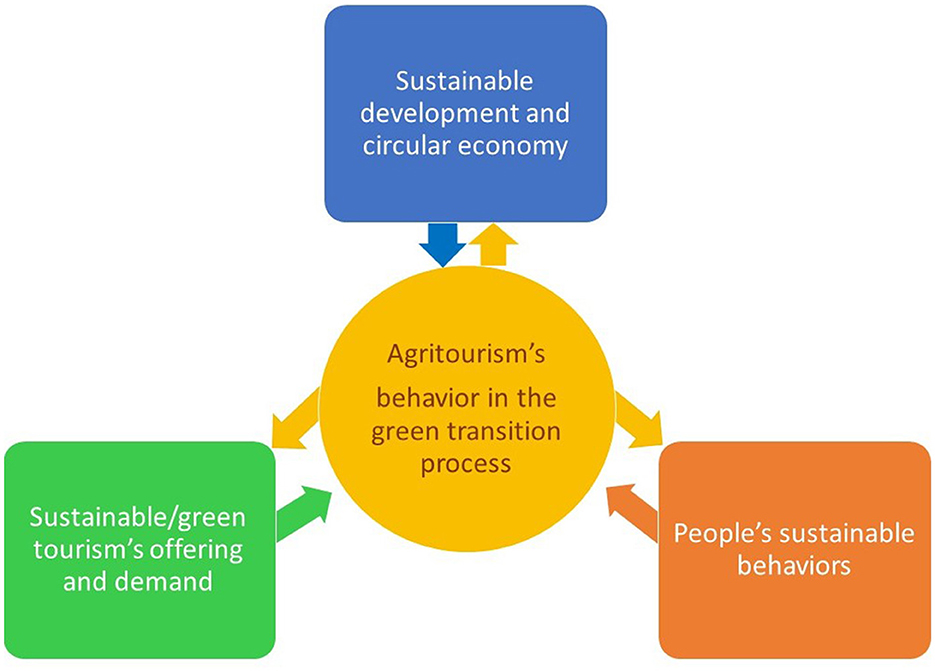
Figure 9. Influences among agritourism's and people's sustainable behaviors and sustainable economy and tourism.
To sum up, even if there are good possibilities for a green transition (in accordance with the EU Green Deal and the CAP aims), significant efforts are required by small farms in rural and disadvantaged areas of the Union. Funds are the basis to achieve the desired changes following policy decisions. Nevertheless, intervention tools for sustainable tourism should be based on a virtuous compromise between increasing competitiveness and controlling the pressures on social, territorial, and environmental systems. Moreover, Italian agritourisms may need help from consultants and experts to access the Italian NRRP funds because of the bureaucratic complexity to respond to public calls. However, agritourism may be the first tourist enterprise that embodies sustainable tourism. Certainly, Italian agritourisms might not be enough to satisfy the increasing offer of green, sustainable, and ethical tourism, because of the Law that limits farmers to privilege farming activity, and therefore they will remain a niche beside the larger offer of rural tourism. For this reason, they need the interest of territorial stakeholders and policymakers. They should be helped to easily access the funds and at the same time promote their precious activity for the territory. They are at the base of rural tourism, food & wine tourism, religious tourism, seasonal tourism, and cultural tourism of a region. Therefore, these activities must be supported at a local level to contribute to enhancing the territorial attractiveness.
5. Conclusion and limitations
The study attempts to provide a broader perspective of the actual situation in Sicily concerning the agritourism's green transition and the role of this type of tourist offer to facilitate the process of awareness and use of positive and sustainable behaviors in the tourist sector among people. Italy is the first European country for a number of farms engaged in organic farming, and southern regions cover a great position among Italian enterprises, which implemented sustainable decisions. Findings demonstrated that the EU agritourisms, in general, may be the main proponents of the green transitions for many reasons. In the first place, the farmhouses bring in themselves, by their very nature, the green transition, also because of the huge financial support of the new CAP aimed to promote structural investments that favor the application, at the firm level, of sustainable processes of resources' use, production, and disposal. These incentives will make this transition inevitable.
Second, agritourism is the guardian of the rural territory and the traditional agricultural landscape, and contributes to the improvement of its quality, in a sustainable perspective. In particular, the quality of air, water, and soil, the production of healthy food and clean energy, the promotion of the circular economy and sustainable mobility, the reduction of architectural barriers, and the animation of socio-economic exchanges among urban, suburban, and rural populations. Agritourism can offer low environmental impact activities that respect local communities, enhance the short supply chain, favor the application of rainwater reuse systems for compatible purposes, and so on.
In addition, the farm, besides being a supplier of quality food and ecosystem services, is also a promoter of healthy behavior and consumption of seasonal local food products by visitors, so it may be a vehicle for adopting the Mediterranean Diet as a lifestyle and sustainable food system.
Moreover, the growing propensity of people to search for ecological products and green services helps the farm to improve and orient itself with greater awareness toward the tourism sector, for more ethical, responsible, and sustainable tourism. In connection with this, outcomes show how important it would be for farmers to differentiate in multifunctionality, consisting of the mix of different offers and professional knowledge. This may help to change from mere farmers to aware tourism entrepreneurs that take care of their territory and exploit it considering it an added value (Bellia et al., 2022).
Finally, one of the most important points is a gradual change in mindset and this can only happen through effective communication, both a firm and institutional level, based on school seminars, tv educational advertising, and population educational campaigns.
In our opinion, the limit of this study is that it was carried out only in one Italian region, albeit representing southern Italy. To confirm the results that emerged both from the side of tourists and entrepreneurs, and validate the model of development of sustainable behavior, it would be interesting to repeat the study in other more developed agricultural regions of both northern Italy and Europe. Moreover, to confirm the results obtained, it would also be interesting to replicate the study in other disadvantaged agricultural regions of the EU where the effects of the application of the CAP deserve to be observed immediately. Finally, it would also be interesting to expand the study by observing the wider offer of rural tourism by those structures that today practice tourist reception activities in villages or rural areas while not being primarily agricultural enterprises at the end to understand if this type of tourist enterprises can be considered competitors of the farmhouses as such.
Data availability statement
The raw data supporting the conclusions of this article will be made available by the authors, without undue reservation.
Ethics statement
Written informed consent for participation was not required for this study in accordance with national legislation and institutional requirements.
Author contributions
MI: conceptualization, methodological design, supervision, validation, and revision of the manuscript until the final draft. MI and PC: study design. MI, MA, and SC: investigation. MA: database organization and formal analysis. SC and CB: project administration and funding acquisition. Particularly, MI wrote the paragraphs: 1. Introduction (with exclusion of sub-paragraphs 1.1. Literature review, 1.2. Law review, 1.3. Brief history of Sicilian agriculture), 2. Materials and methods, 4. Discussion, 5. Conclusions and limitations. CB wrote: 1.1. Literature review. LA wrote: 1.2. Law review. SB wrote: 1.3. Brief history of Sicilian agriculture; of the paragraph 3. Results. SB and MI wrote: 3.1. Results of agritourisms analysis. MI wrote: 3.1.1. Focus on agritourism's green transition and sustainable behavior choices. SC wrote: 3.2. Results of tourist analysis. SC and MI wrote: 3.2.1. Focus on tourists' sustainable behavior and choices; finally, the proposed model shown in Figure 1 was developed by MI and SB; the Agritourism tourists' profile illustrated in Figure 8 was developed by MI and SC and the proposed model shown in Figure 9 was developed by MI. All authors contributed to writing-original draft preparation, read and agreed to the published version of the manuscript, and approved the submitted version.
Funding
This research was partially funded by Research Project Sostenibilitá Economica, Ambientale e Sociale del Sistema Agroalimentare del Mediterraneo, Principal investigator CB funded by Piano di Incentivi per la Ricerca di Ateneo (PIACERI) UNICT 2020/22 line 2, UPB: 5A722192154, University of Catania and also by the UNIPA-FFR2021 Stefania Chironi.
Conflict of interest
The authors declare that the research was conducted in the absence of any commercial or financial relationships that could be construed as a potential conflict of interest.
Publisher's note
All claims expressed in this article are solely those of the authors and do not necessarily represent those of their affiliated organizations, or those of the publisher, the editors and the reviewers. Any product that may be evaluated in this article, or claim that may be made by its manufacturer, is not guaranteed or endorsed by the publisher.
Supplementary material
The Supplementary Material for this article can be found online at: https://www.frontiersin.org/articles/10.3389/fsufs.2023.1174623/full#supplementary-material
References
Aguiñaga, E., Henriques, I., Scheel, C., and Scheel, A. (2018). Building resilience: a self-sustainable community approach to the triple bottom line. J. Clean. Prod. 173, 186–196. doi: 10.1016/j.jclepro.2017.01.094
Andersen, M. S. (2007). An introductory note on the environmental economics of the circular economy. Sustain. Sci. 2, 133–140. doi: 10.1007/s11625-006-0013-6
Bacarella, A. (2021). Storia moderna dell'agricoltura siciliana: dall'anteguerra ai giorni nostri. Vol. 1–2. Palermo: La Zisa
Badami, A. A. (2021). Managing the historical agricultural landscape in the sicilian anthropocene, context and the landscape of the valley of the temples as a time capsule. Sustainability 13, 4480. doi: 10.3390/su13084480
Bellia, C., Columba, P., and Ingrassia, M. (2022). The brand–land identity of Etna Volcano valley wines: a policy delphi study. Agriculture 12, 811. doi: 10.3390/agriculture12060811
Bellia, C., and Pilato, M. (2014). Competitiveness of wine business within green economy: Sicilian case. Qual. Acc. Success 138, 74–78.
Bellia, C., Scavone, V., and Ingrassia, M. (2021). Food and religion in Sicily—a new green tourist destination by an ancient route from the past. Sustainability 13, 6686. doi: 10.3390/su13126686
Benedetto, G., and Giordano, A. (2008). Sicily. Mediterranean Island Lands. Nat. Cult. Approach. 9, 117–142. doi: 10.1007/978-1-4020-5064-0_7
Bocken, N. M., De Pauw, I., Bakker, C., and Van Der Grinten, B. (2016). Product design and business model strategies for a circular economy. J. Indus. Prod. Eng. 33, 308–320. doi: 10.1080/21681015.2016.1172124
Boulding, K. E. (1966a). The economics of knowledge and the knowledge of economics. Am. Econ. Rev. 56, 1–13.
Boulding, K. E. (1966b). The economics of the coming spaceship earth. In: Jarrett, H., editor. Environmental Quality in a Growing Economy. Baltimore: The Johns Hopkins Press. p. 3–14.
Bresciani, F., Dévé, F. C., and Stringer, R. (2004). “The multiple roles of agriculture in developing countries,” in Sustaining Agriculture and the Rural Economy: Governance, Policy and Multifunctionality. p. 286-306.
Charonis, G. K. (2012). “Degrowth, steady state economics and the circular economy: three distinct yet increasingly converging alternative discourses to economic growth for achieving environmental sustainability and social equity,” in World Economic Association Sustainability Conference, Vol. 24. p. 1–18.
Chironi, S., Bacarella, S., Altamore, L., Columba, P., and Ingrassia, M. (2021). Consumption of spices and ethnic contamination in the daily diet of Italians-consumers' preferences and modification of eating habits. J. Ethnic Foods 8, 1–16. doi: 10.1186/s42779-021-00082-8
Curtis, K. R., and Slocum, S. L. (2016). The role of sustainability certification programs in reducing food waste in tourism. J. Dev. Sustain. Agri. 11, 1–7.
Darǎu, A. P., Corneliu, M., Brad, M. L., and Avram, E. (2010). The Concept of Rural Tourism and Agritourism. Arad: Studia Universitatis “Vasile Goldis”. p. 39–42.
Ecker, S., Clarke, R., Cartwright, S., Kancans, R., Please, P., and Binks, B. (2010). Drivers of Regional Agritourism and Food Tourism in Australia. Available online at: https://apo.org.au/sites/default/files/resource-files/2010-01/apo-nid150976.pdf (accessed February 22, 2023).
Edizioni Europee (2023a). Legge 5 dicembre 1985, n. 730. Disciplina dell'agriturismo. Available online at: http://www.edizionieuropee.it/law/html/89/zn96_02_019.html (accessed February 23, 2023).
Edizioni Europee (2023b). L. 20 febbraio 2006, n. 96. Disciplina dell'agriturismo. Available online at: http://www.edizionieuropee.it/law/html/90/zn96_02_033.html (accessed February 23, 2023).
EU (2015). Closing the Loop - An EU Action Plan for the Circular Economy COM/2015/0614 Final. Available online at: https://www.eea.europa.eu/policy-documents/com-2015-0614-final (accessed February 22, 2023).
European Commission. (2010). On the European Union's Humanitarian Aid and Civil Protection Policies and Their Implementation. European Commission.Available online at: https://ec.europa.eu/echo/files/media/publications/annual_report/annual_report_2010.pdf (accessed February 26, 2023).
European Commission. (2015). Sustainable Development in the European Union. Available online at: https://ec.europa.eu/eurostat/documents/3217494/6975281/KS-GT-15-001-EN-N.pdf (accessed February 25, 2023).
European Environment Agency (1998). Europe's Environment: The second assessment. Amsterdam: Elsevier Science Limited.
European Parliament (2015). Economia circolare: definizione, importanza e vantaggi. Available online at: https://www.europarl.europa.eu/news/it/headlines/economy/20151201STO05603/economia-circolare-definizione-importanza-e-vantaggi (accessed February 24, 2023).
Geissdoerfer, M., Morioka, S. N., de Carvalho, M. M., and Evans, S. (2018). Business models and supply chains for the circular economy. J. Clean. Prod. 190, 712–721. doi: 10.1016/j.jclepro.2018.04.159
Geissdoerfer, M., Savaget, P., Bocken, N. M., and Hultink, E. J. (2017). The circular economy–a new sustainability paradigm? J. Clean. Prod. 143, 757–768. doi: 10.1016/j.jclepro.2016.12.048
Geng, Y., and Doberstein, B. (2008). Developing the circular economy in China: Challenges and opportunities for achieving 'leapfrog development'. Int. J. Sustain. Dev. World Ecol. 15, 231–239. doi: 10.3843/SusDev.15.3:6
George, D. A., Lin, B. C. A., and Chen, Y. (2015). A circular economy model of economic growth. Environ. Model. Softw. 73, 60–63. doi: 10.1016/j.envsoft.2015.06.014
Ghisellini, P., and Ulgiati, S. (2020). Circular economy transition in Italy. Achievements, perspectives and constraints. J. Clean. Prod. 243, 118360. doi: 10.1016/j.jclepro.2019.118360
Gómez, M., and Martinez, M. M. (2023). Redistribution of surplus bread particles into the food supply chain. LWT 173, 114281. doi: 10.1016/j.lwt.2022.114281
Iannetta, M., and Padovani, L. M. (2015). La Dieta Mediterranea: modello di consumo sostenibile a ridotto impatto ambientale. Available online at: https://www.enea.it/it/seguici/pubblicazioni/pdf-eai/speciale-eneaxexpo/dieta-mediterranea-modello-di-consumo.pdf (accessed February 22, 2023).
Ingrassia, M., Altamore, L., Bellia, C., Grasso, G. L., Silva, P., Bacarella, S., et al. (2022a). Visitor's motivational framework and wine routes' contribution to sustainable agriculture and tourism. Sustainability 14, 12082. doi: 10.3390/su141912082
Ingrassia, M., Chironi, S., Lo Grasso, G., Gristina, L., Francesca, N., Bacarella, S., et al. (2022b). Is environmental sustainability also “Economically Efficient”? The case of the “SOStain” certification for sicilian sparkling wines. Sustainability 14, 7359. doi: 10.3390/su14127359
ISTAT (2023a). Available online at: http://dati.istat.it/# (accessed May 31, 2023).
ISTAT (2023b). Available online at: https://www.istat.it/it/archivio/277798 (accessed February 14, 2023).
Kachniewska, M. A. (2015). Tourism development as a determinant of quality of life in rural areas. Worldwide Hosp. Tourism Theme. 7, 500–515. doi: 10.1108/WHATT-06-2015-0028
Keränen, O., Lehtimäki, T., Komulainen, H., and Ulkuniemi, P. (2023). Changing the market for a sustainable innovation. Indust. Market. Manag. 108, 108–121. doi: 10.1016/j.indmarman.2022.11.005
Kim, S., Lee, S. K., Lee, D., Jeong, J., and Moon, J. (2019). The effect of agritourism experience on consumers' future food purchase patterns. Tour. Manag. 70, 144–152. doi: 10.1016/j.tourman.2018.08.003
Kirchherr, J., Reike, D., and Hekkert, M. (2017). Conceptualizing the circular economy: an analysis of 114 definitions. Resour. Conserv. Recycl. 127, 221–232. doi: 10.1016/j.resconrec.2017.09.005
Korstanje, M. E., and George, B. P. (2020). “Education as a strategy to tackle over tourism for overtourism and inclusive sustainability in the twenty-first century,” in Overtourism: Causes, Implications and Solutions. p. 341–359. doi: 10.1007/978-3-030-42458-9_18
MacArthur Foundation Google (2019). Artificial Intelligence and the Circular Economy: AI as a Tool to Accelerate the Transition. Available online at: https://www.mckinsey.com/business-functions/sustainability/our-insights/artificial-intelligence-and-the-circular-economy-ai-as-a-tool-to-accelerate-the-transition
Macarthur Foundation. (2013). What is a Circular Economy? Available online at: https://www.mckinsey.com/capabilities/sustainability/our-insights/artificial-intelligence-and-the-circulareconomy-ai-as-a-tool-to-accelerate-the-transition (accessed February 18, 2023).
Markose, N., Vazhakkatte Tazhathethil, B., and George, B. (2022). Sustainability initiatives for green tourism development: the case of Wayanad, India. J. Risk Finan. Manag. 15, 52. doi: 10.3390/jrfm15020052
McKinsey. (2022). No Time to Waste: What Plastics Recycling Could Offer. Available online at: https://www.mckinsey.com/industries/chemicals/our-insights/no-time-to-waste-what-plastics-recyclingcould-offer (accessed December 15, 2022).
Melo Ribeiro, H. C., and de Souza, M. T. S. (2022). Economía circular y turismo: producción científica a la luz de un análisis de redes sociales. Estudios Gerenciales 38, 385–402. doi: 10.18046/j.estger.2022.164.5086
Merli, R., Preziosi, M., and Acampora, A. (2018). How do scholars approach the circular economy? A systematic literature review. J. Clean. Product. 178, 703–722. doi: 10.1016/j.jclepro.2017.12.112
Murray, A., Skene, K., and Haynes, K. (2017). The circular economy: an interdisciplinary exploration of the concept and application in a global context. J. Busin. Ethics 140, 369–380. doi: 10.1007/s10551-015-2693-2
Nocca, F., Bosone, M., De Toro, P., and Fusco Girard, L. (2023). Towards the human circular tourism: recommendations actions, and multidimensional indicators for the tourist category. Sustainability 15, 1845. doi: 10.3390/su15031845
Pappalardo, G., Sisto, R., and Pecorino, B. (2018). Is the partnership governance able to promote endogenous rural development? A preliminary assessment under the Adaptive Co-management approach. Eur. Countryside 10, 543–565. doi: 10.2478/euco-2018-0031
Pearce, D. W., and Turner, R. K. (1990). Economics of Natural Resources and the Environment. Baltimore: The Johns Hopkins University Press.
Pedrotti, M., Daniele, F., Marta, A., and Bob, C. (2023). Approaching urban food waste in low- and middle-income countries: a framework and evidence from case studies in Kibera (Nairobi) and Dhaka. Sustainability 15, 3293. doi: 10.3390/su15043293
Phelan, C., and Sharpley, R. (2011). Exploring agritourism entrepreneurship in the UK. Tour. Plann. Dev. 8, 121–136. doi: 10.1080/21568316.2011.573912
Pollard, S., Turney, A., Charnley, F., and Webster, K. (2016). The circular economy–a reappraisal of the ‘stuff'we love. Geography 101, 17–27. doi: 10.1080/00167487.2016.12093979
Renting, H., Rossing, W. A., Groot, J. C., Van der Ploeg, J. D., Laurent, C., Perraud, D., et al. (2009). Exploring multifunctional agriculture. A review of conceptual approaches and prospects for an integrative transitional framework. J. Environ. Manag. 90, S112–S123. doi: 10.1016/j.jenvman.2008.11.014
Rodríguez, C., Florido, C., and Jacob, M. (2020). Circular economy contributions to the tourism sector: a critical literature review. Sustainability 12, 4338. doi: 10.3390/su12114338
Safonte, G. F., Bellia, C., and Columba, P. (2021). Commoning of territorial heritage and tools of participated sustainability for the production and enhancement of agro-environmental public goods. Agricult. Food Econ. 9, 1–20. doi: 10.1186/s40100-021-00180-w
Santucci, F. M. (2013). Agritourism for rural development in italy, evolution, situation and perspectives. J. Econ. Manag. Trade 3, 186–200. doi: 10.9734/BJEMT/2013/3558
Scheepens, A. E., Vogtländer, J. G., and Brezet, J. C. (2016). Two life cycle assessment (LCA) based methods to analyse and design complex (regional) circular economy systems. Case: making water tourism more sustainable. J. Clean. Prod. 114, 257–268. doi: 10.1016/j.jclepro.2015.05.075
Selvaggi, R., and Valenti, F. (2021). Assessment of fruit and vegetable residues suitable for renewable energy production: GIS-based model for developing new frontiers within the context of circular economy. Appl. Syst. Innov. 4, 10. doi: 10.3390/asi4010010
Sisto, R., Cappelletti, G. M., Bianchi, P., and Sica, E. (2022). Sustainable and accessible tourism in natural areas: a participatory approach. Current Issues Tour. 25, 1307–1324. doi: 10.1080/13683500.2021.1920002
Streifeneder, T., and Dax, T. (2020). Agritourism in Europe: enabling factors and current developments of sustainable on-farm tourism in rural areas. In: Global Opportunities and Challenges for Rural and Mountain Tourism. Hershey, PA: IGI Global. p. 40–58.
United Nations (1993). Integrated Environmental and Economic Accounting: Interim Version, Handbook of National Accounting (interim version). New York, NY: United Nations.
United Nations (2003). European Commission, International Monetary Fund, Organization for Economic Co-operation and Development, and World Bank, Handbook of National Accounting: Integrated Environmental and Economic Accounting. New York, NY: United Nations.
Whitfield, S., Challinor, A. J., and Rees, R. M. (2018). Frontiers in climate smart food systems: outlining the research space. Front. Sustain. Food Syst. 2, 2. doi: 10.3389/fsufs.2018.00002
Woodward, R. (2004). The organisation for economic cooperation and development: global monitor. N. Pol. Econ. 9, 113–127. doi: 10.1080/1356346042000190411
Yang, Z., Cai, J., and Sliuzas, R. (2010). Agro-tourism enterprises as a form of multi-functional urban agriculture for peri-urban development in China. Habitat Int. 34, 374–385. doi: 10.1016/j.habitatint.2009.11.002
Keywords: sustainable development, rural tourism, multifunctional agriculture, CAP, sampling survey, green transition, European funding, agri-food system
Citation: Ingrassia M, Bacarella S, Bellia C, Columba P, Adamo MM, Altamore L and Chironi S (2023) Circular economy and agritourism: a sustainable behavioral model for tourists and farmers in the post-COVID era. Front. Sustain. Food Syst. 7:1174623. doi: 10.3389/fsufs.2023.1174623
Received: 26 February 2023; Accepted: 01 June 2023;
Published: 30 June 2023.
Edited by:
Gary Wingenbach, Texas A&M University, United StatesReviewed by:
Roberta Sisto, University of Foggia, ItalyRaffaella Pergamo, Council for Agricultural and Economics Research (CREA), Italy
Copyright © 2023 Ingrassia, Bacarella, Bellia, Columba, Adamo, Altamore and Chironi. This is an open-access article distributed under the terms of the Creative Commons Attribution License (CC BY). The use, distribution or reproduction in other forums is permitted, provided the original author(s) and the copyright owner(s) are credited and that the original publication in this journal is cited, in accordance with accepted academic practice. No use, distribution or reproduction is permitted which does not comply with these terms.
*Correspondence: Luca Altamore, bHVjYS5hbHRhbW9yZUB1bmlwYS5pdA==
 Marzia Ingrassia
Marzia Ingrassia Simona Bacarella
Simona Bacarella Claudio Bellia2
Claudio Bellia2 Pietro Columba
Pietro Columba Marzia Maria Adamo
Marzia Maria Adamo Luca Altamore
Luca Altamore